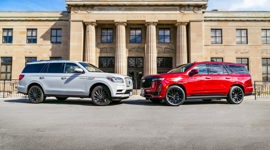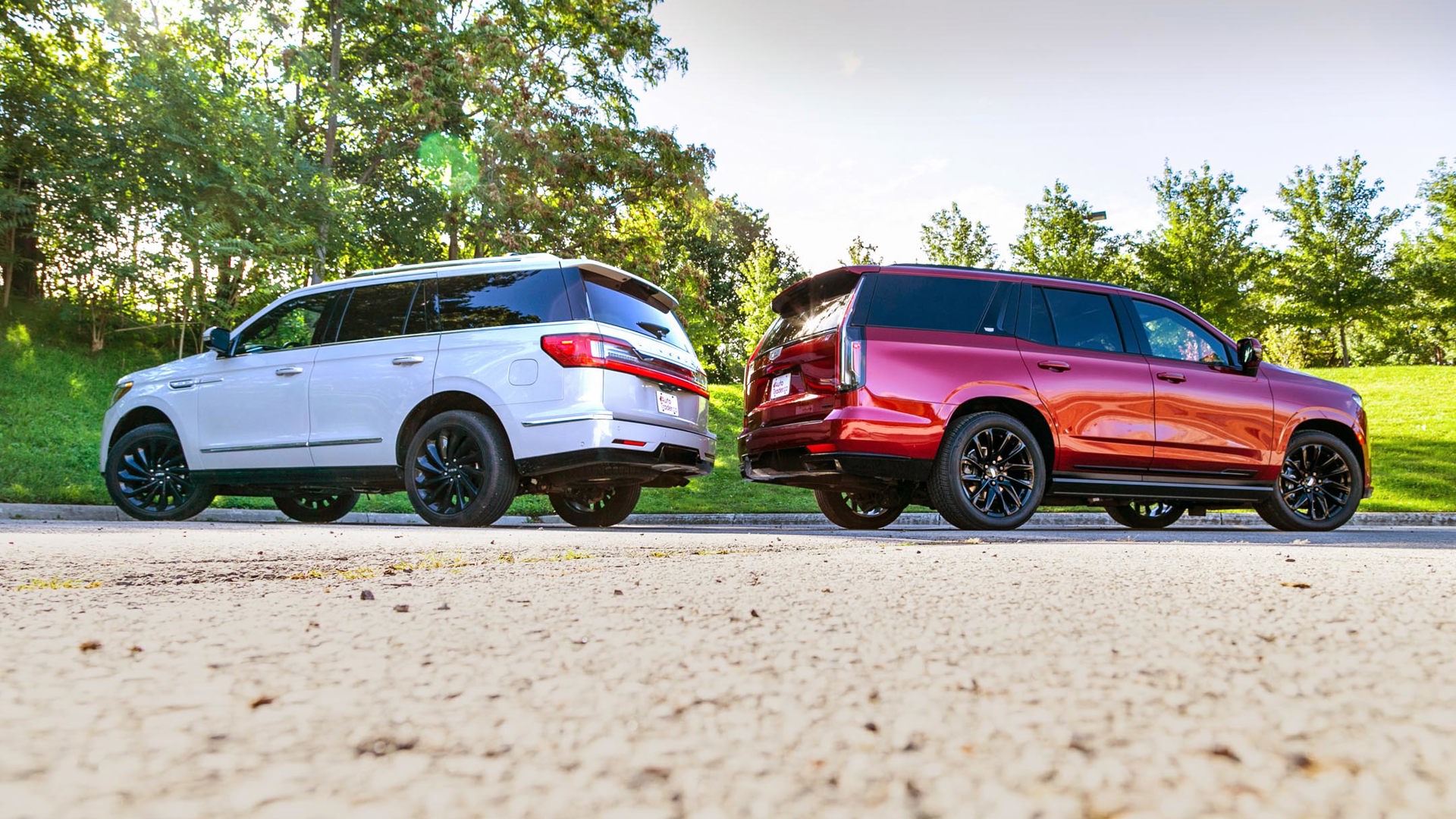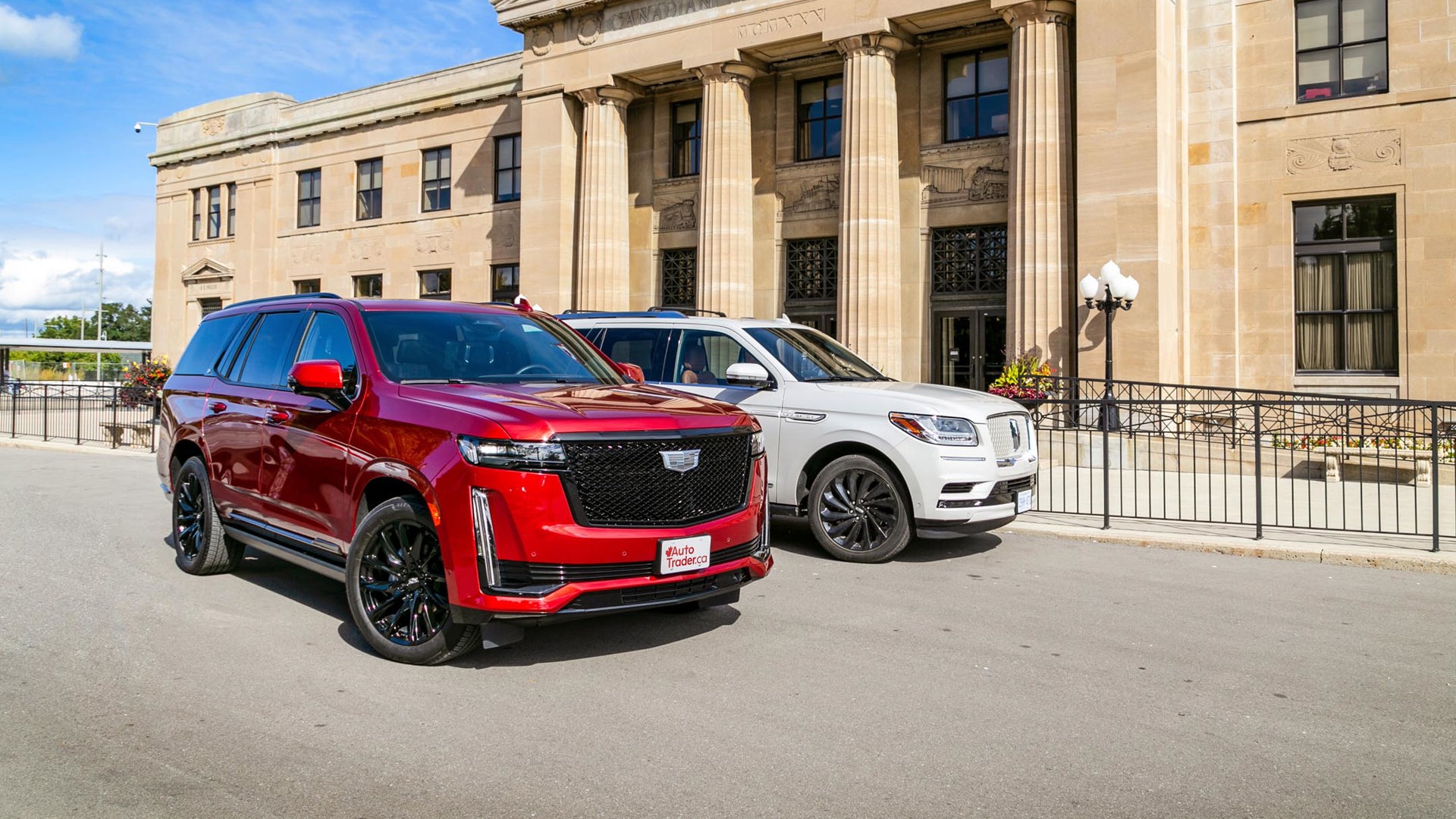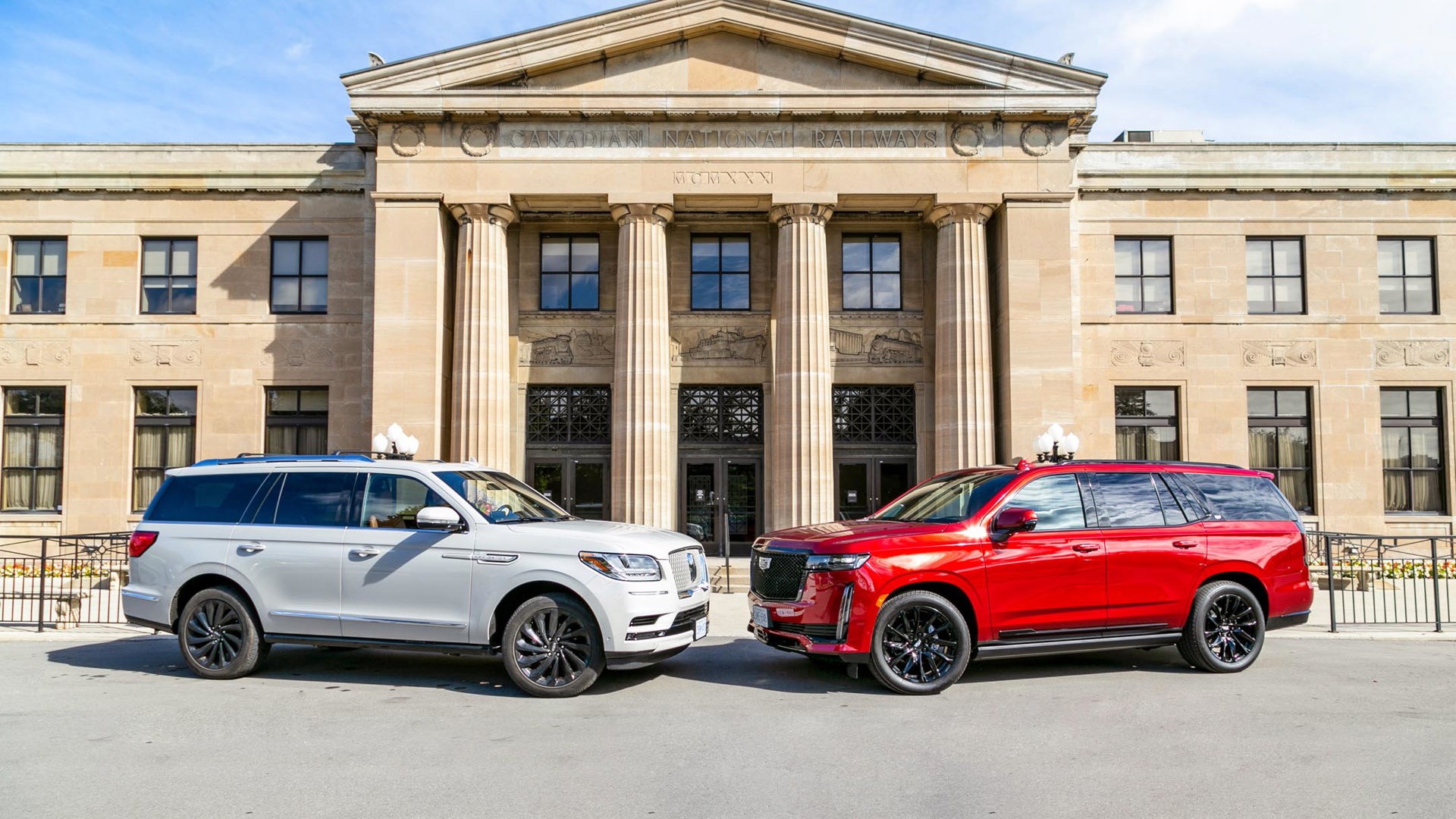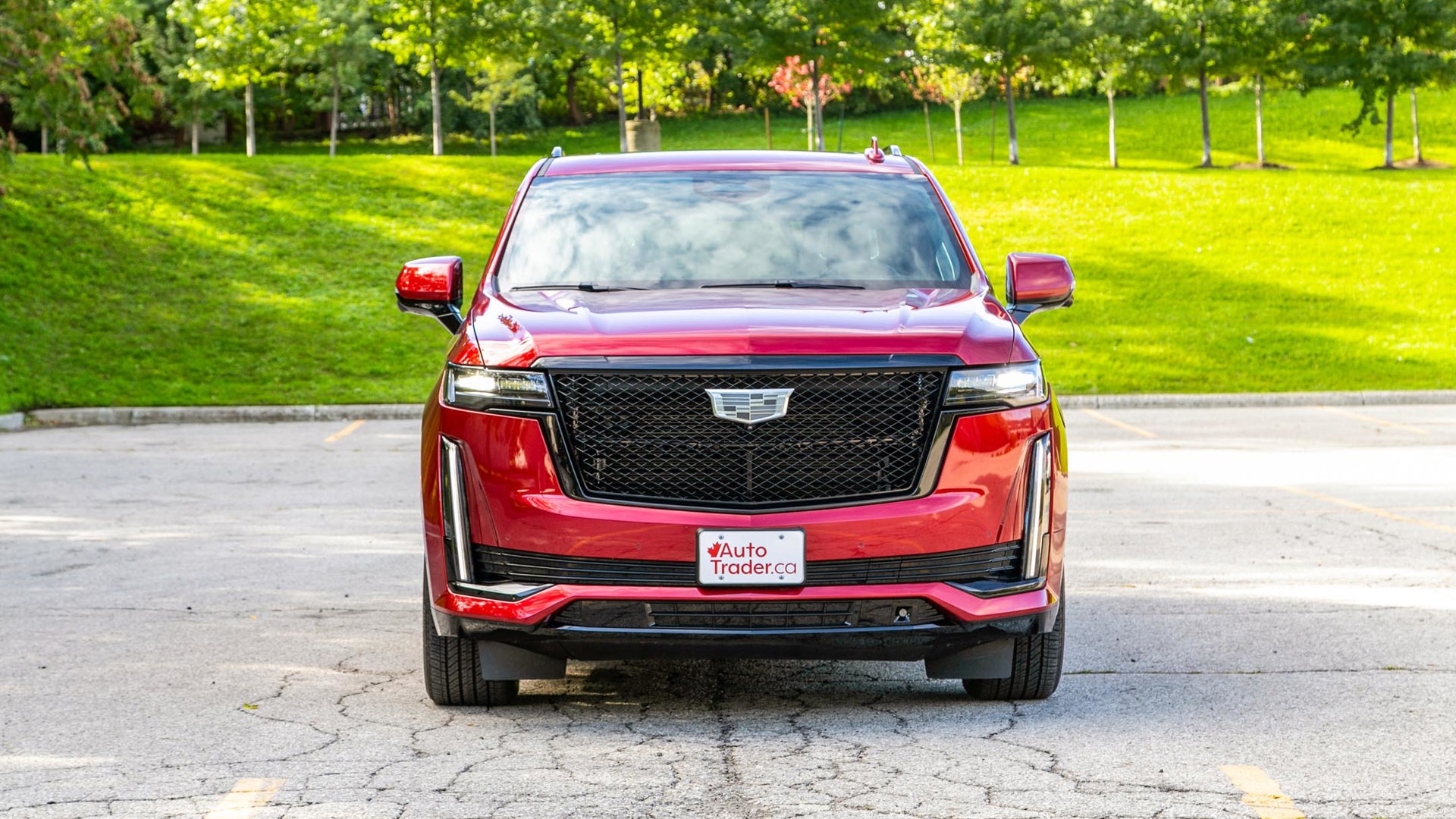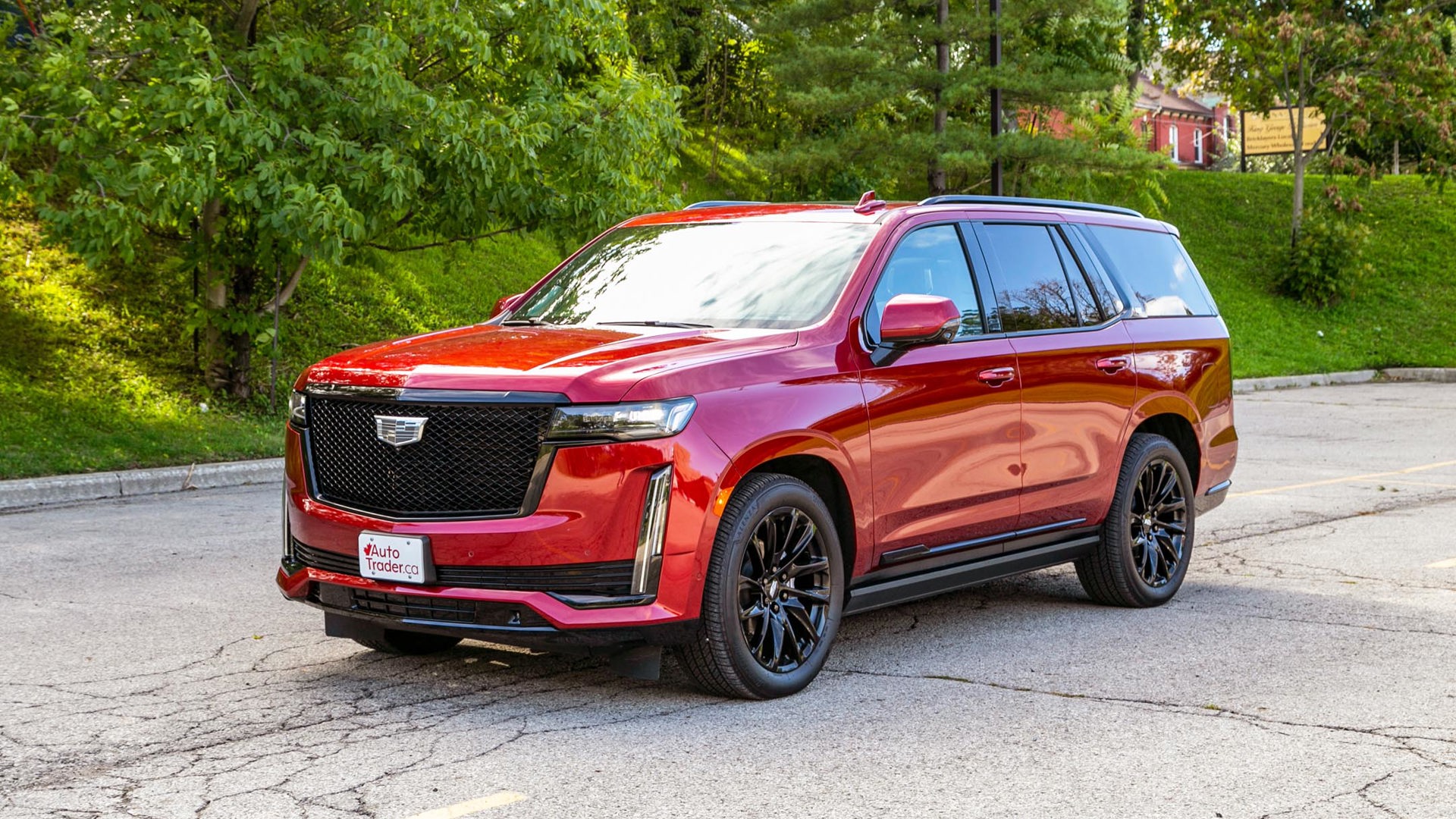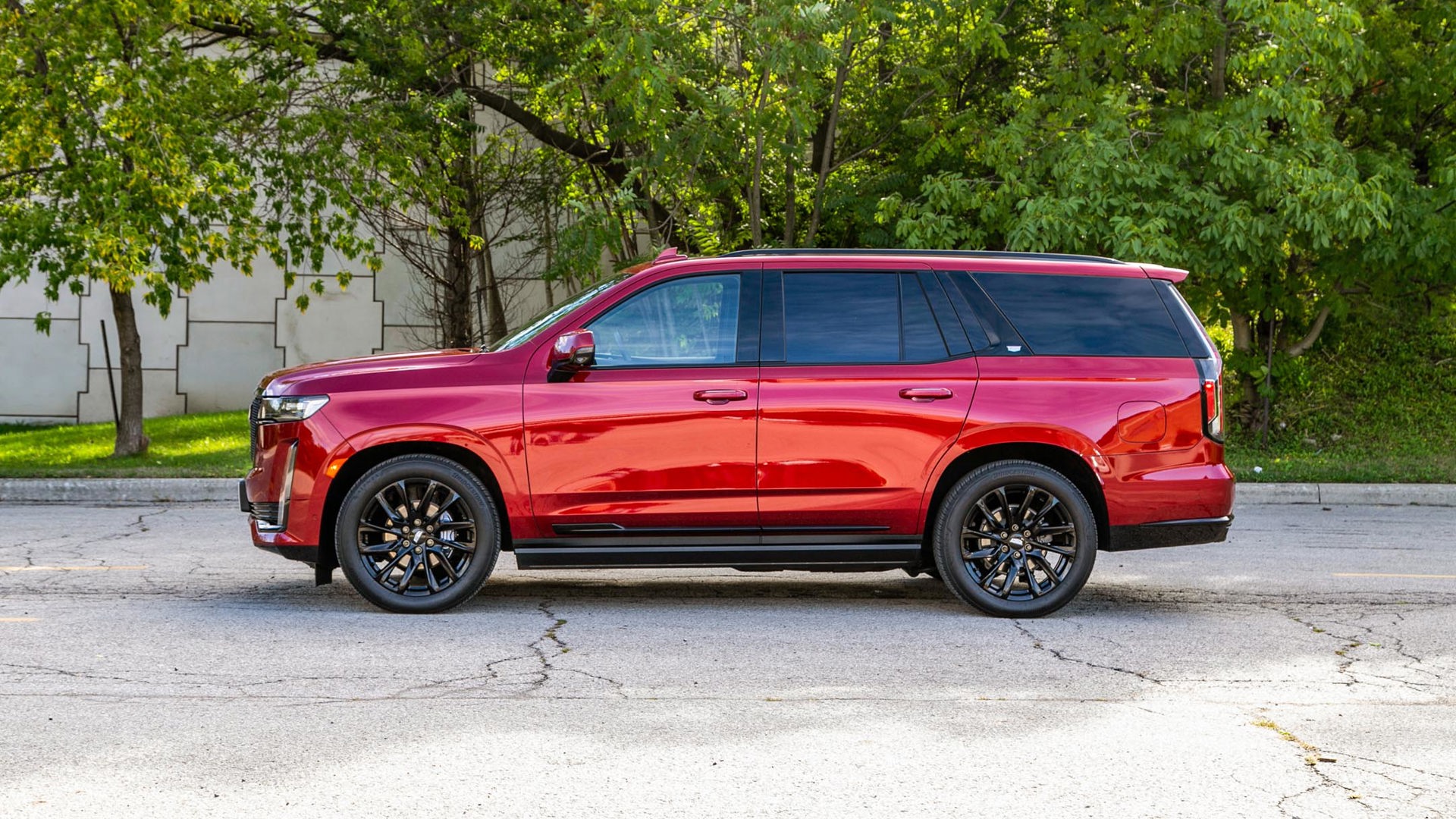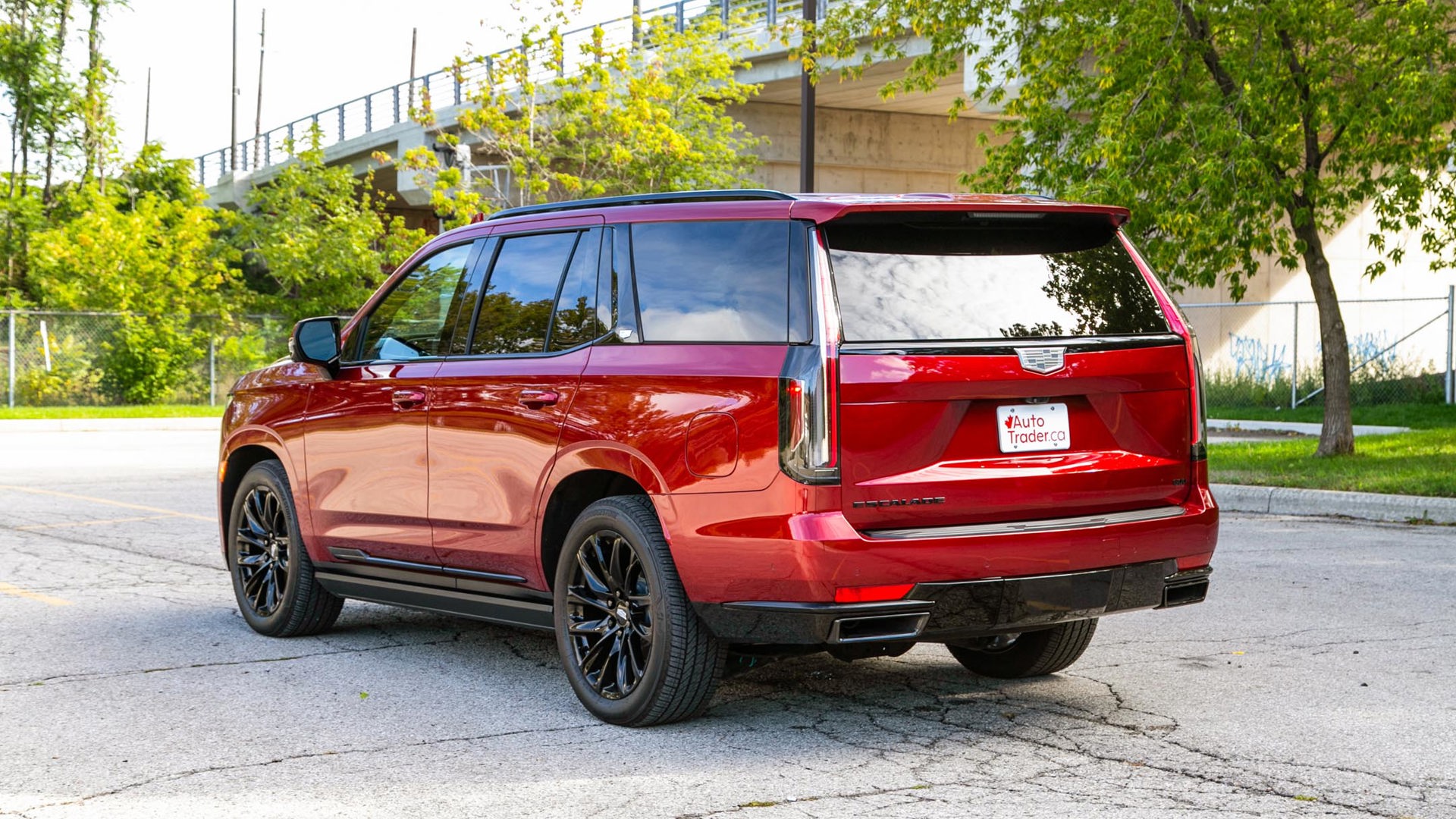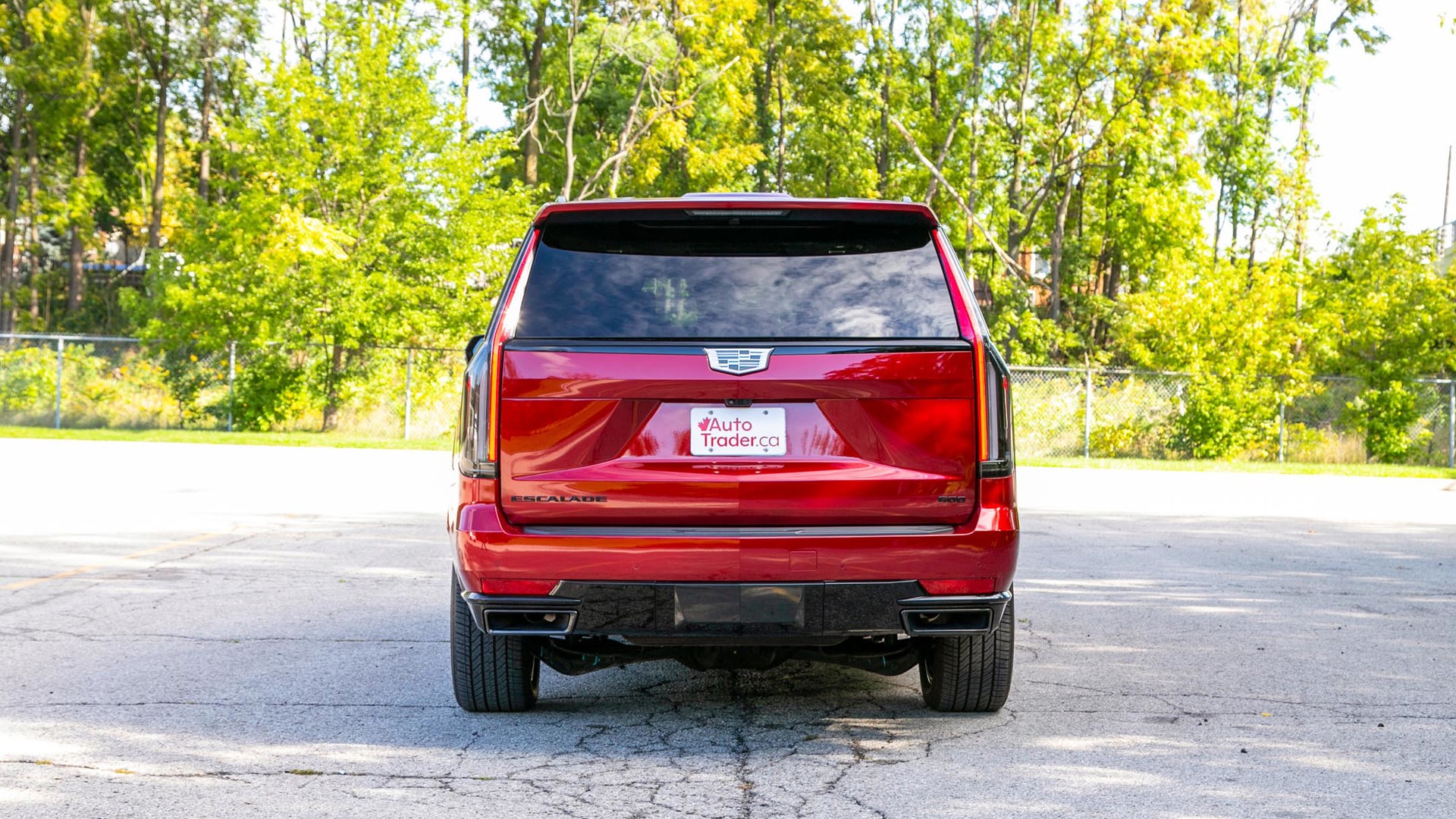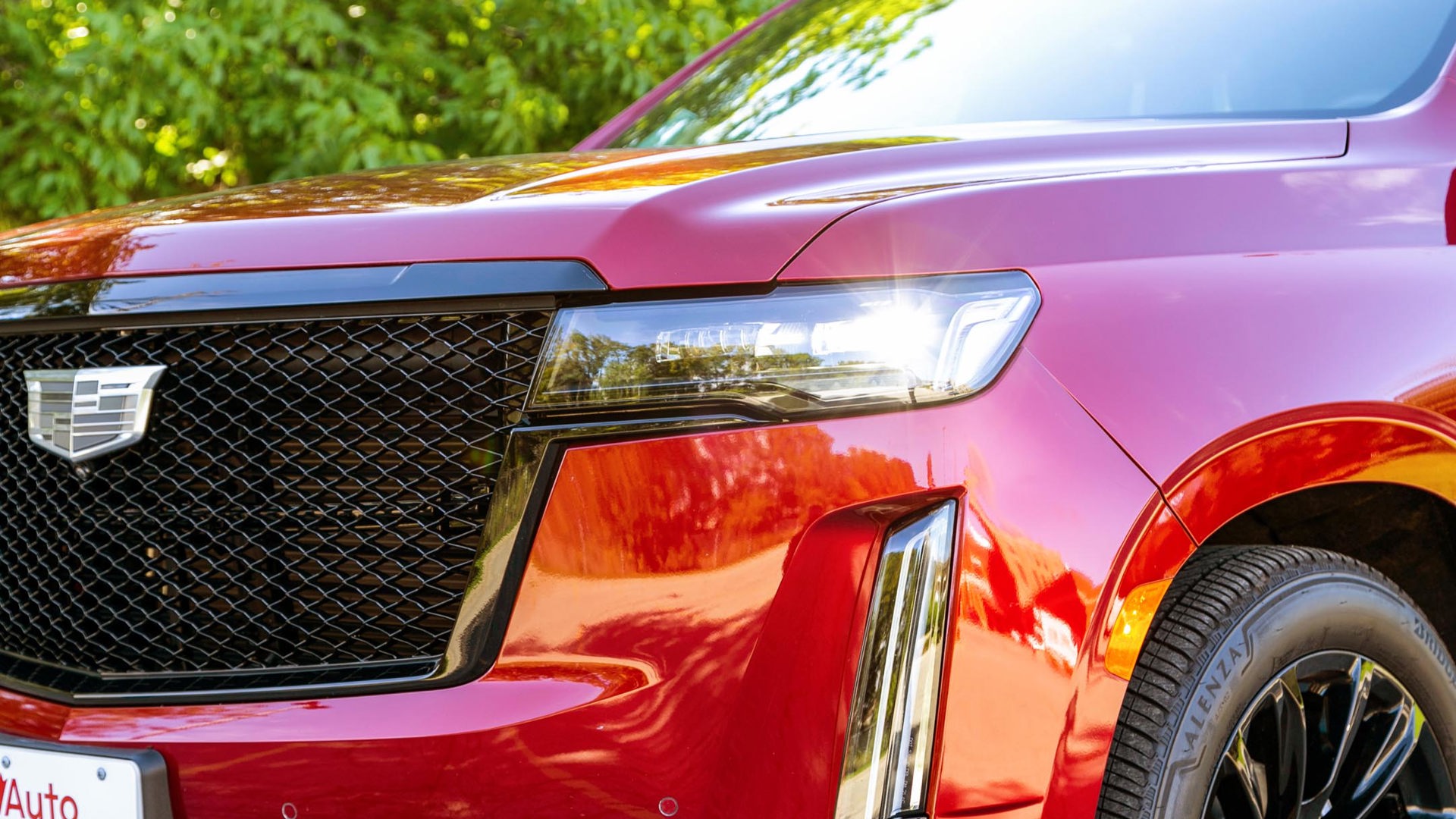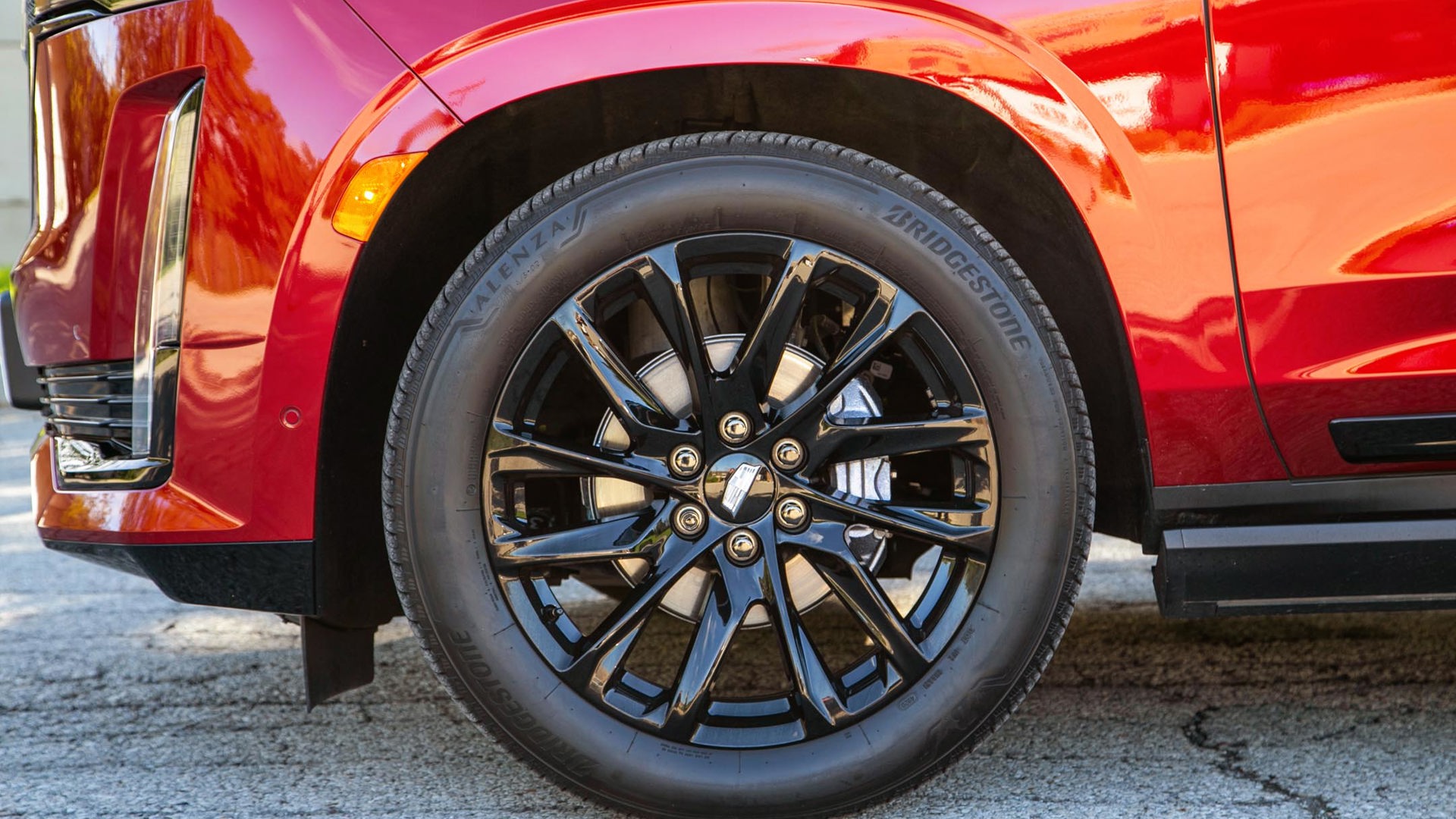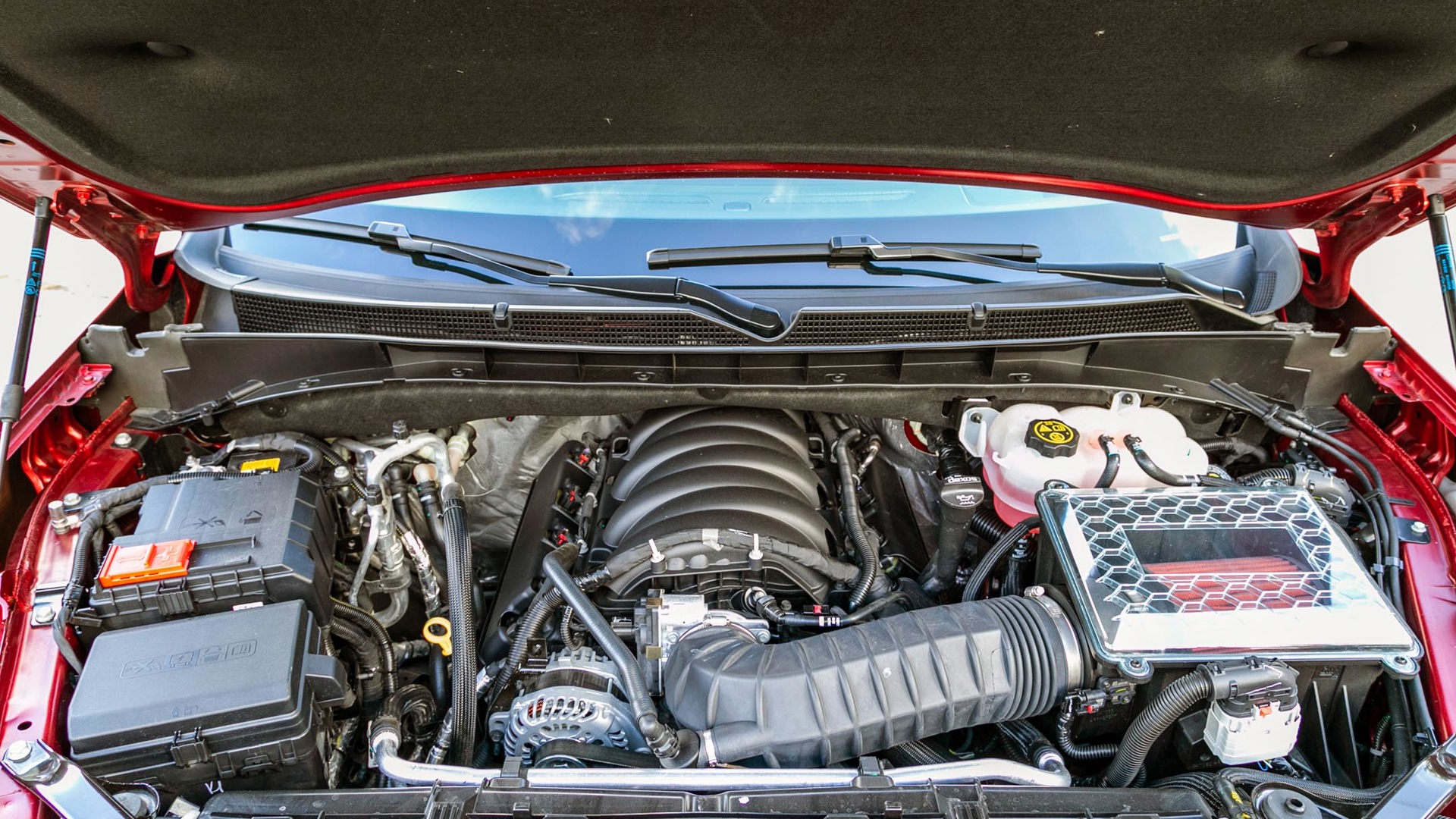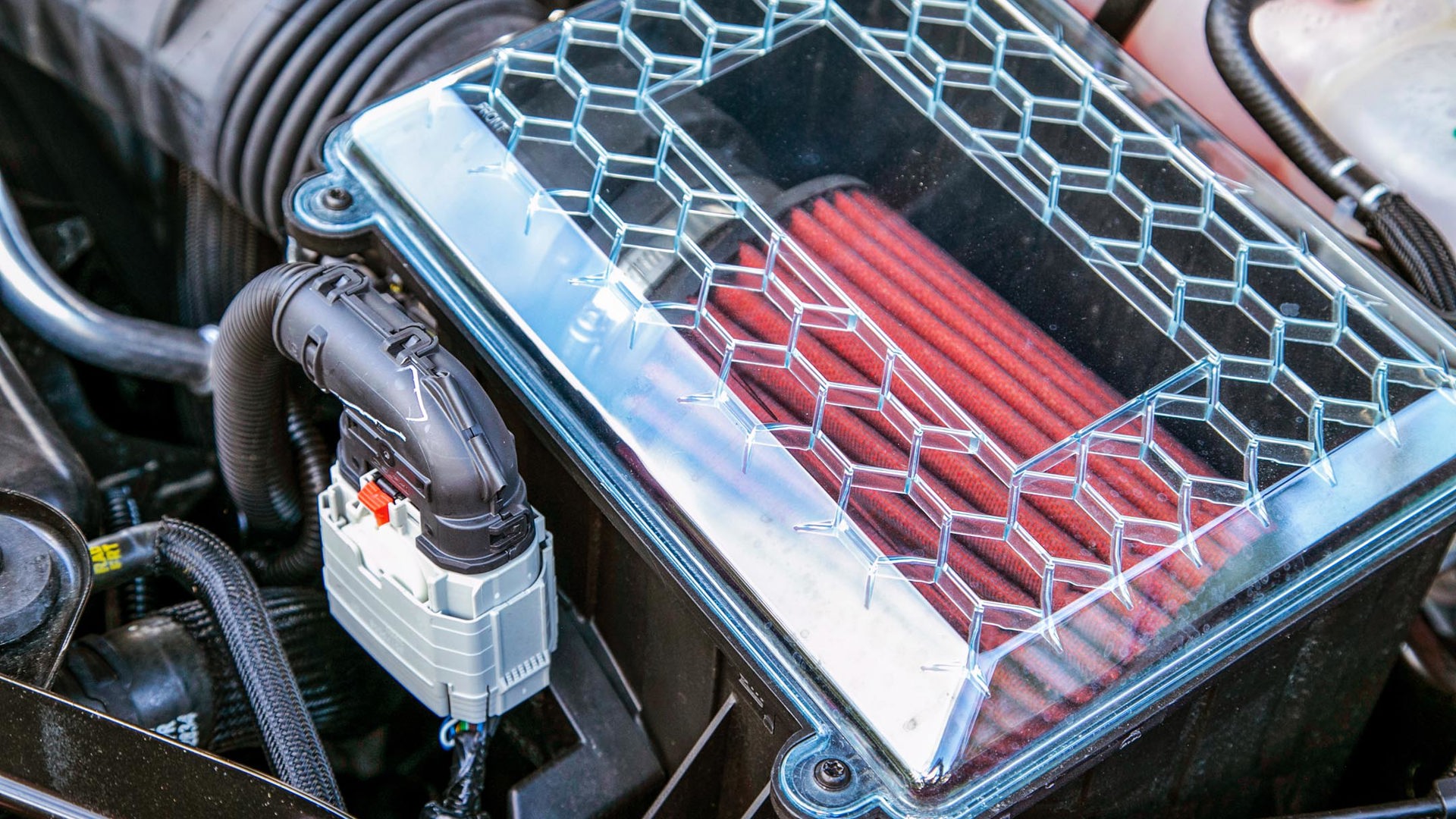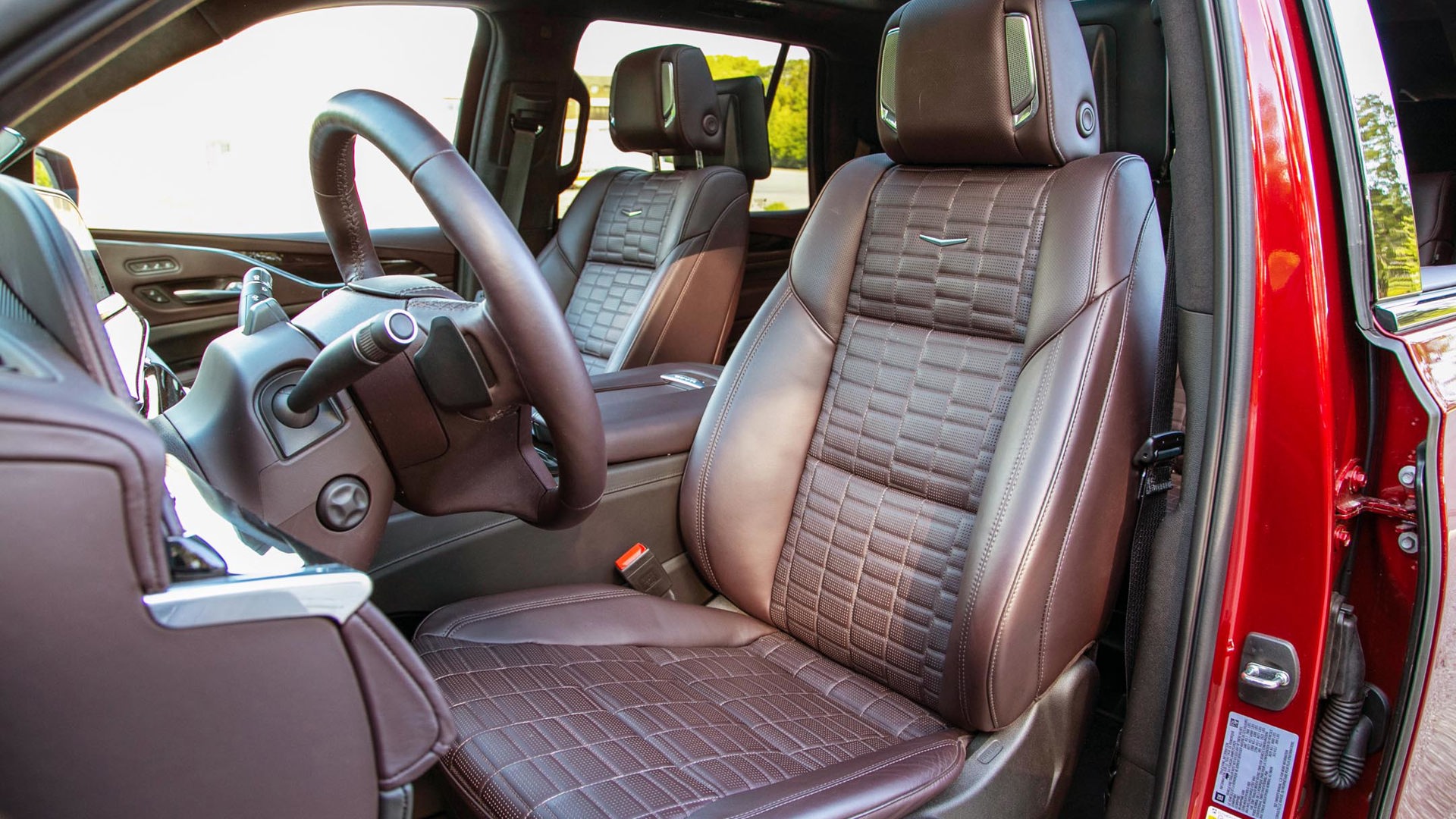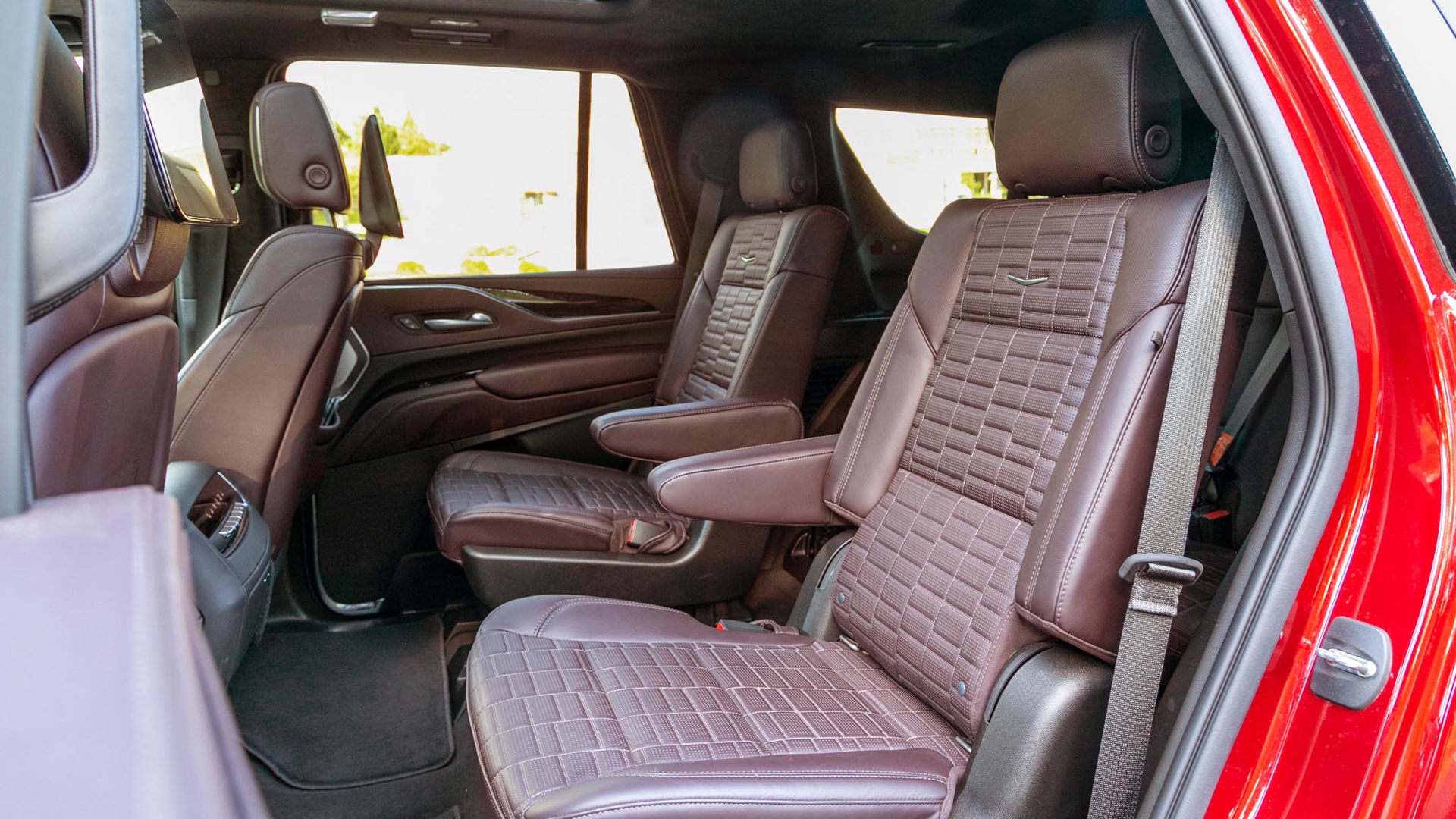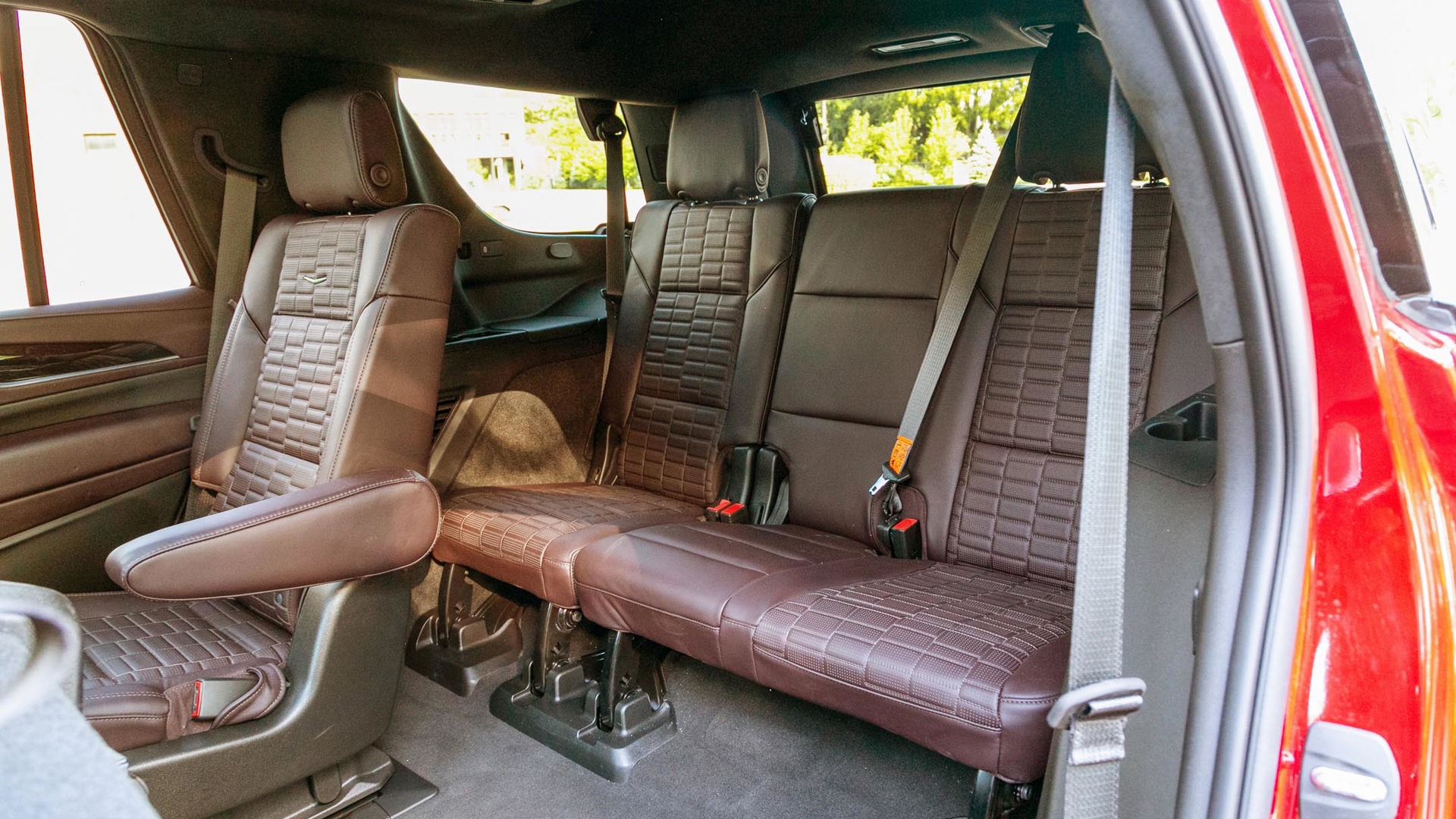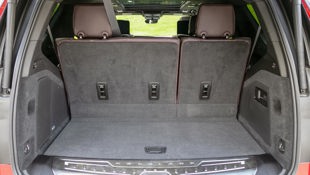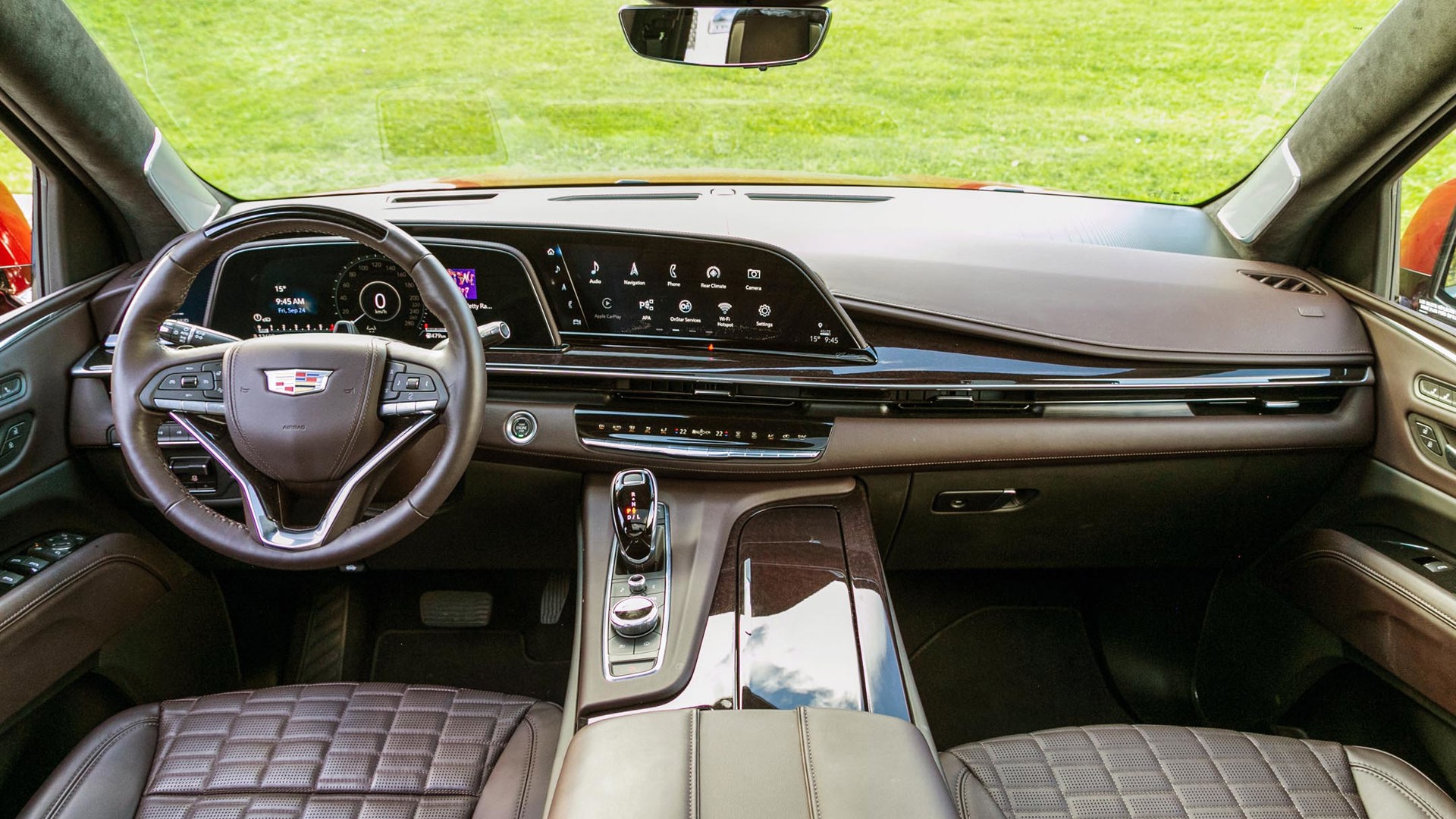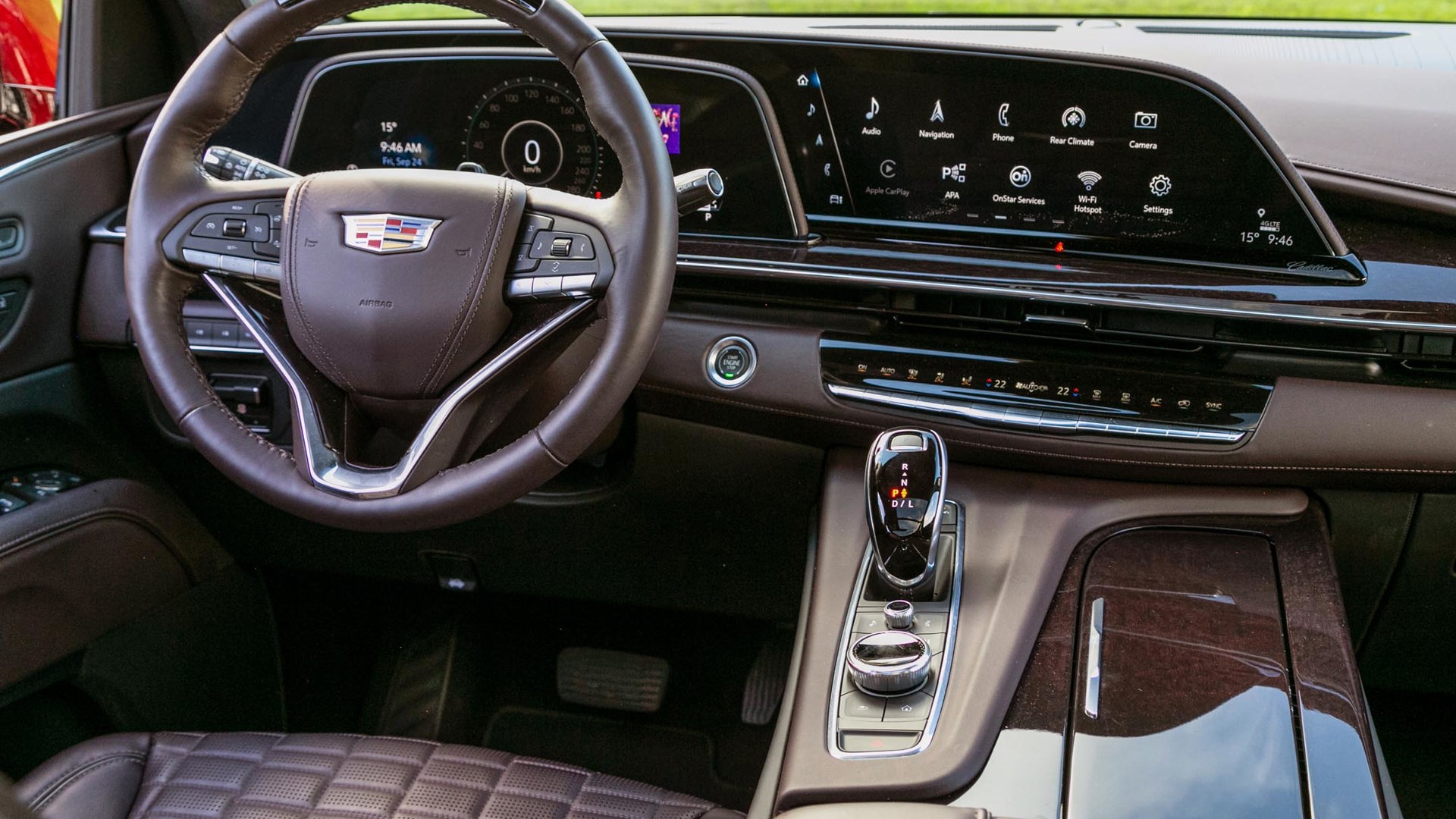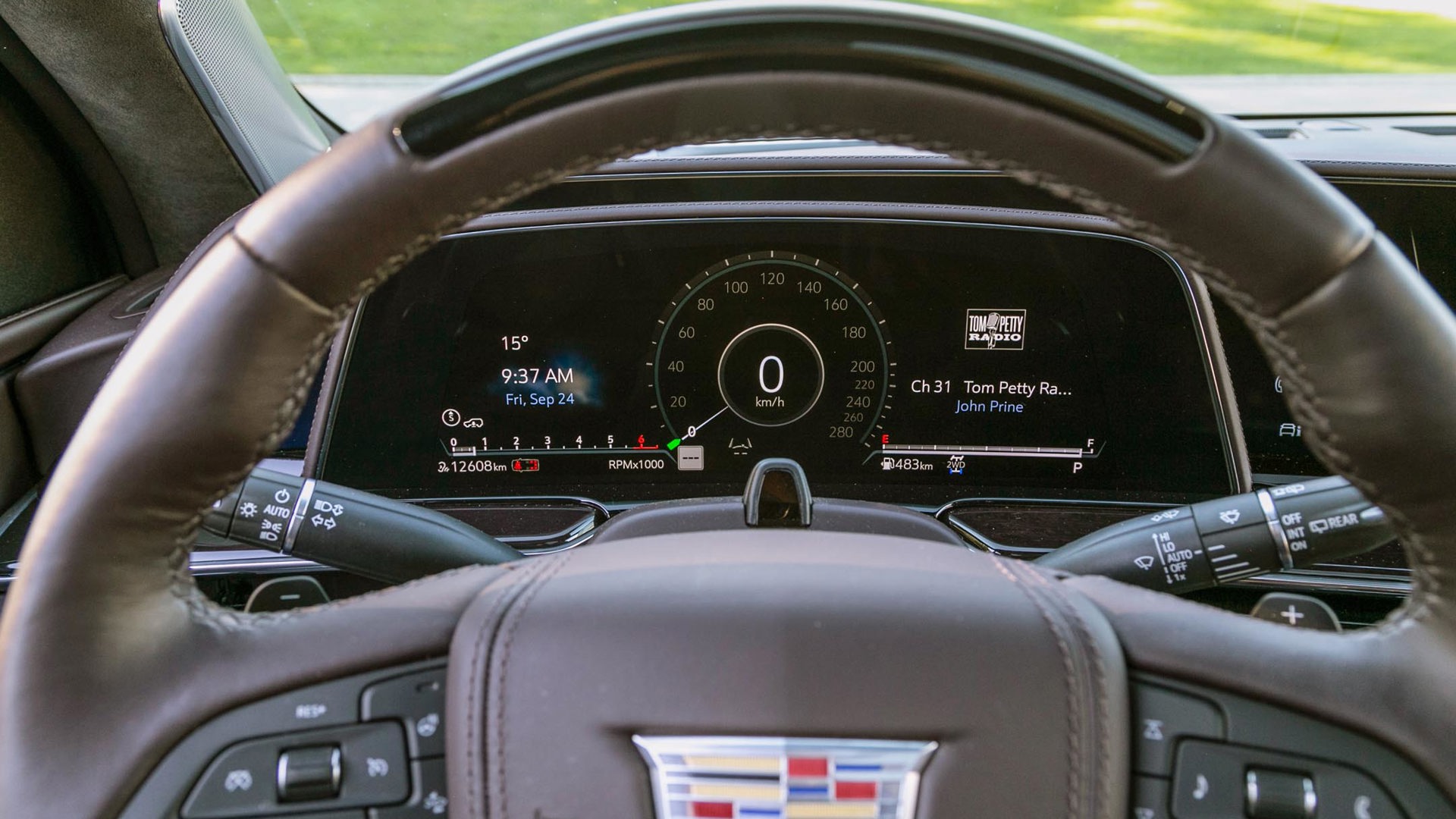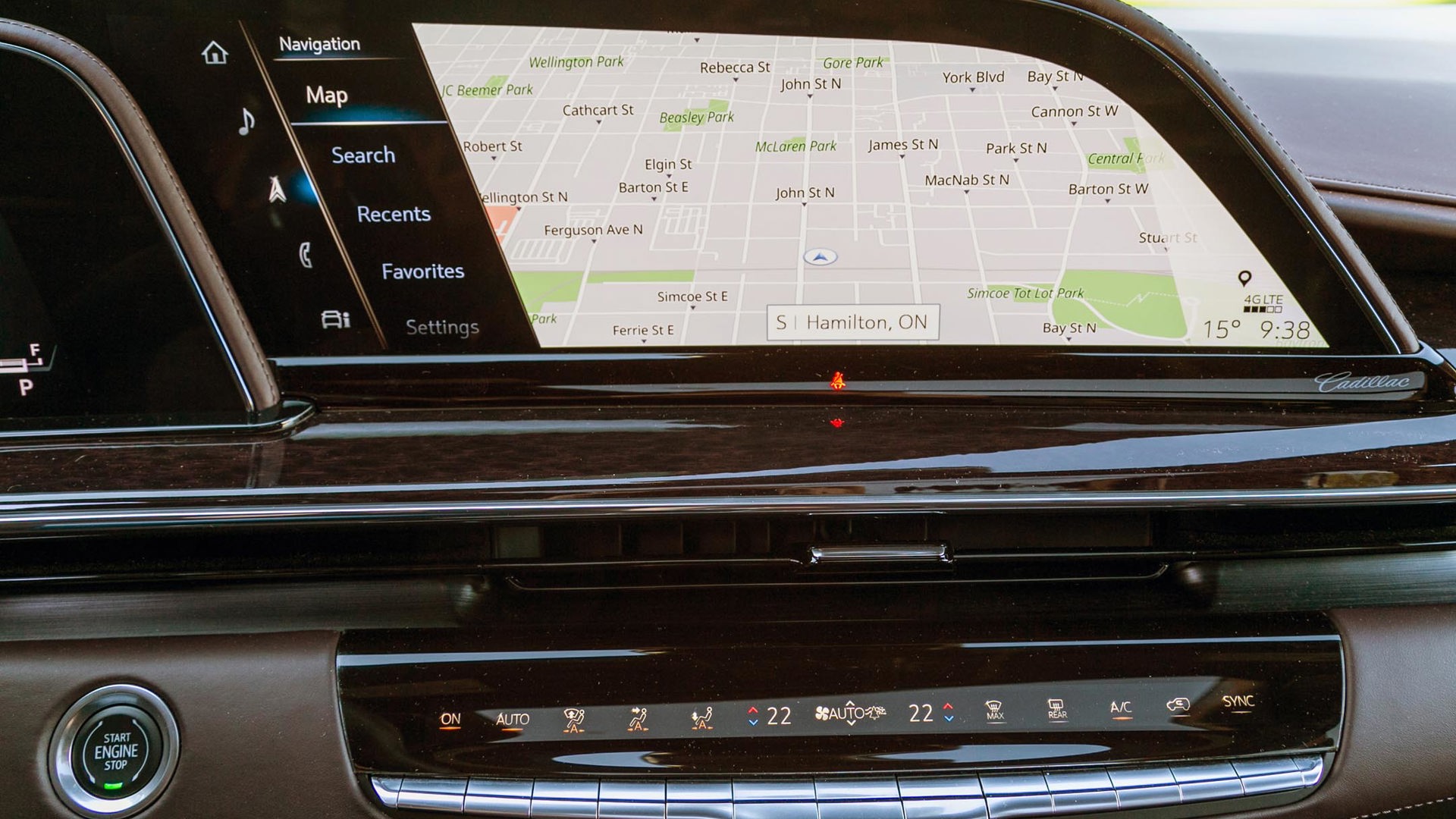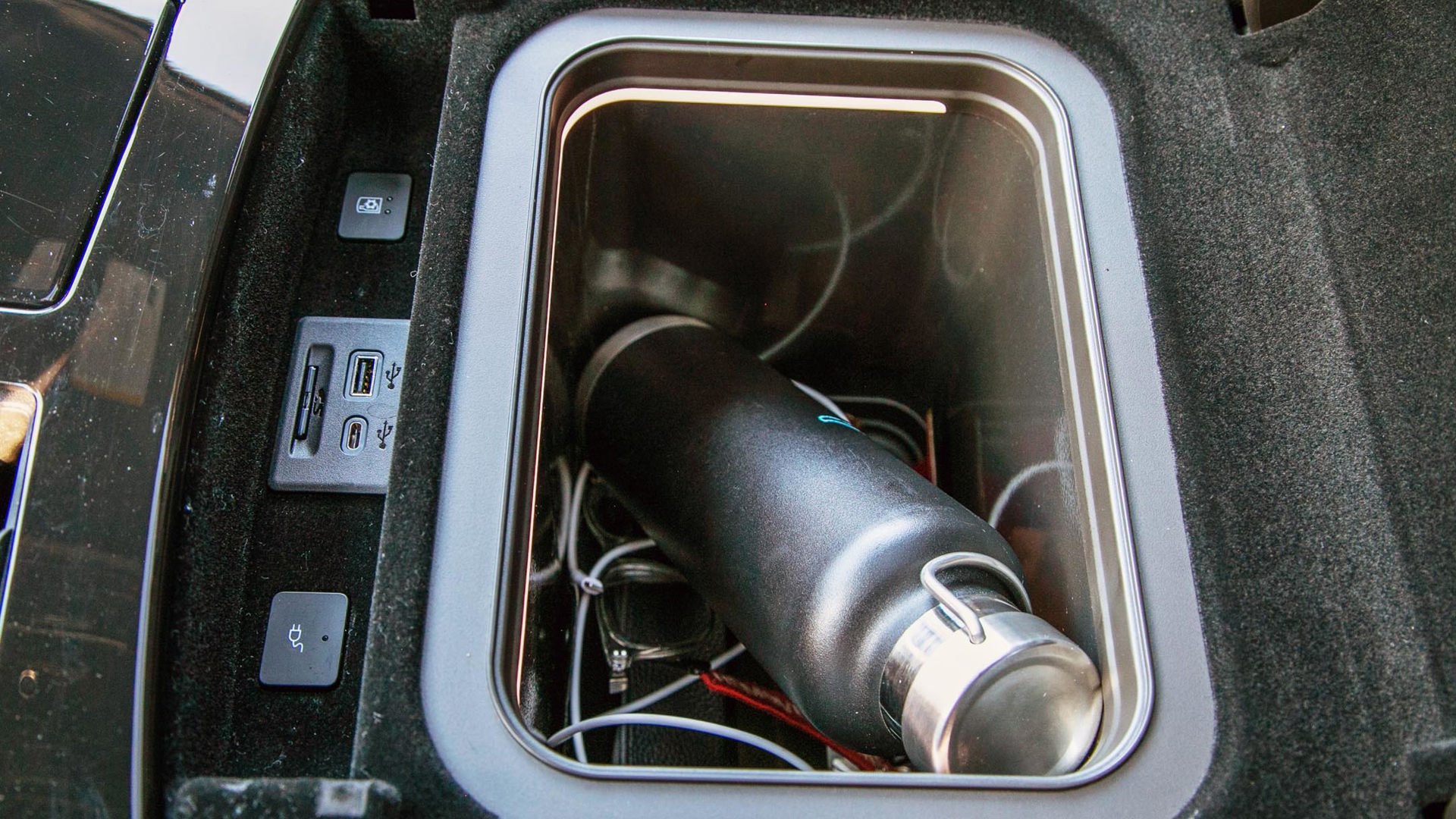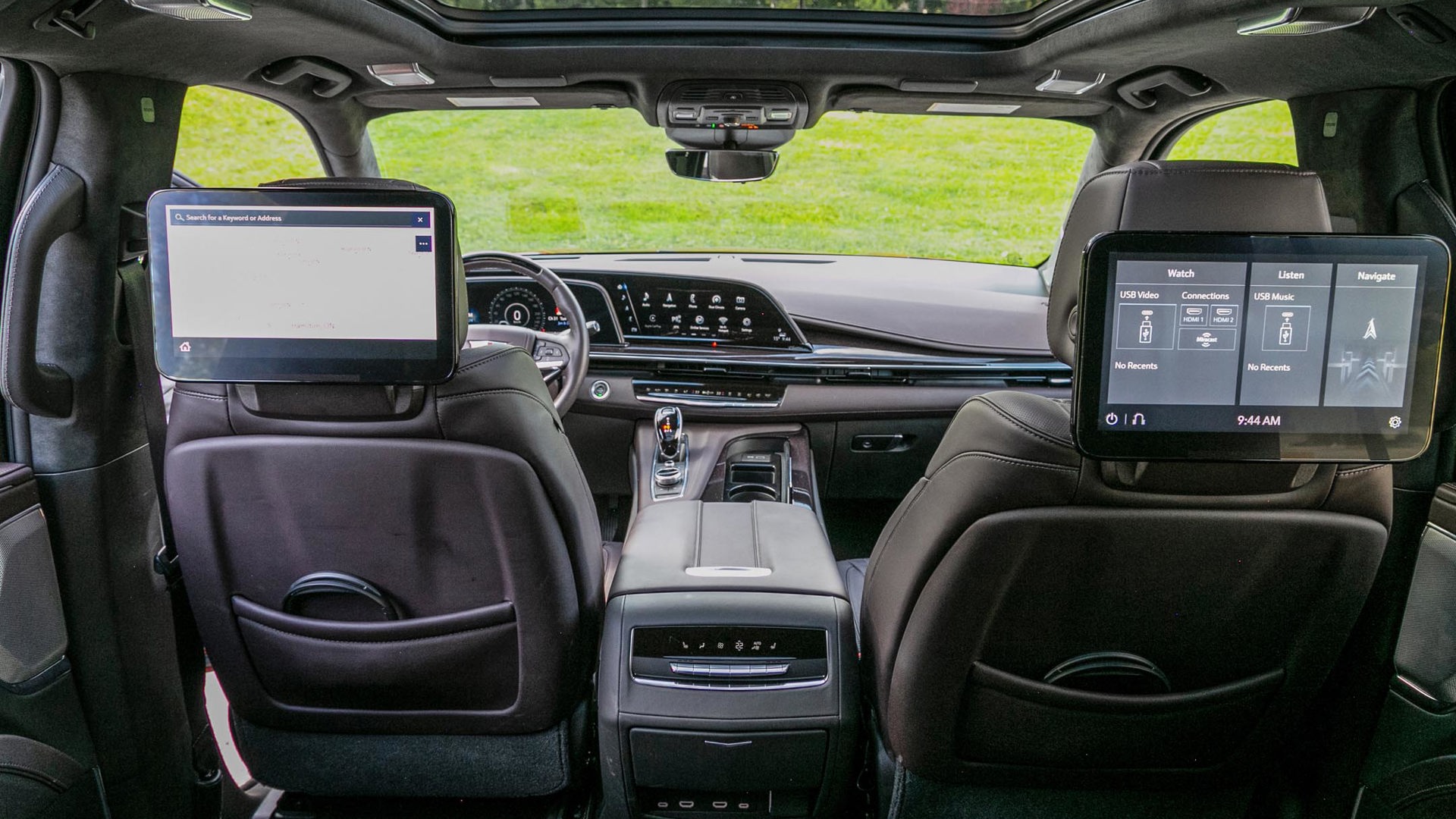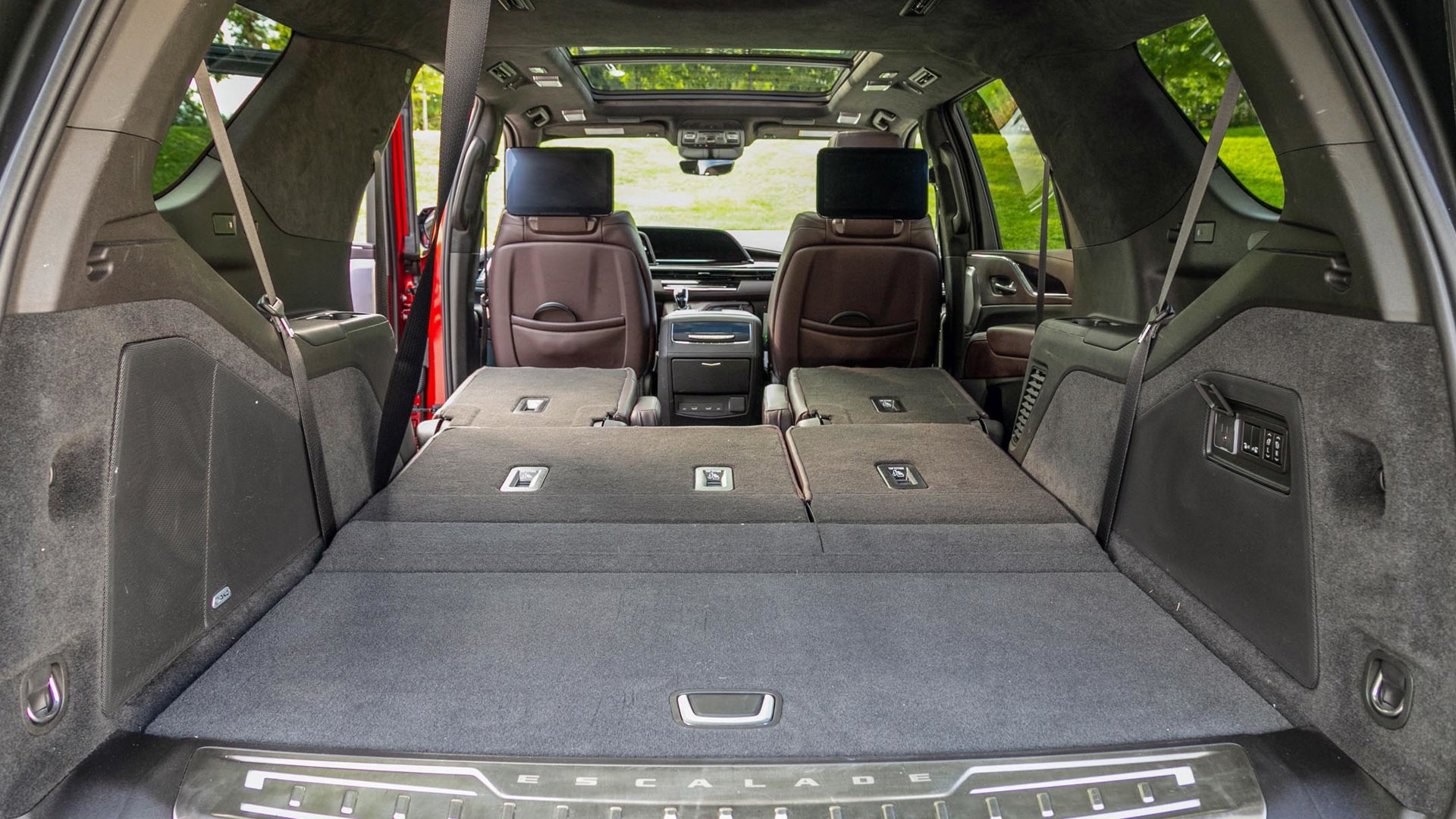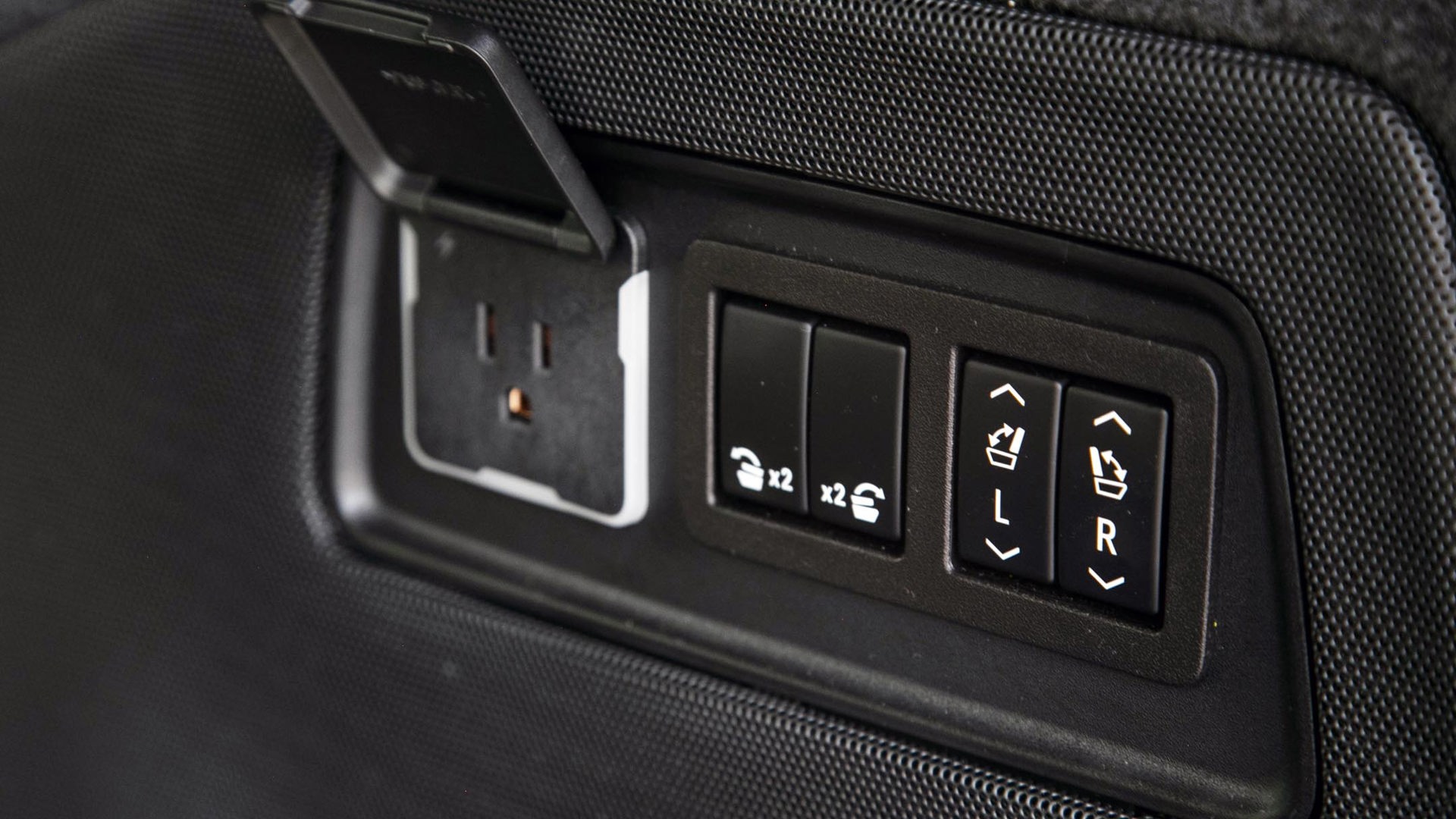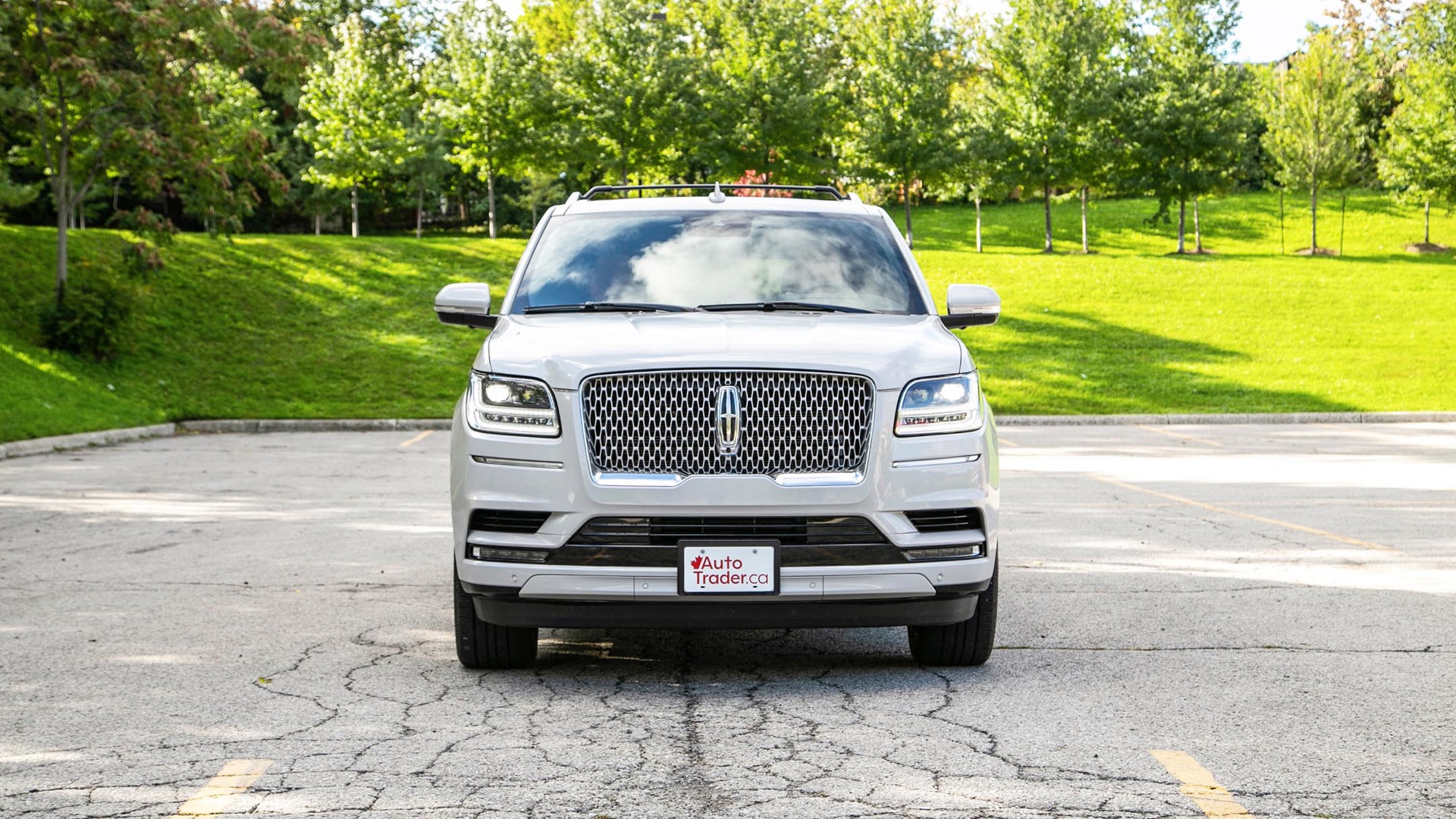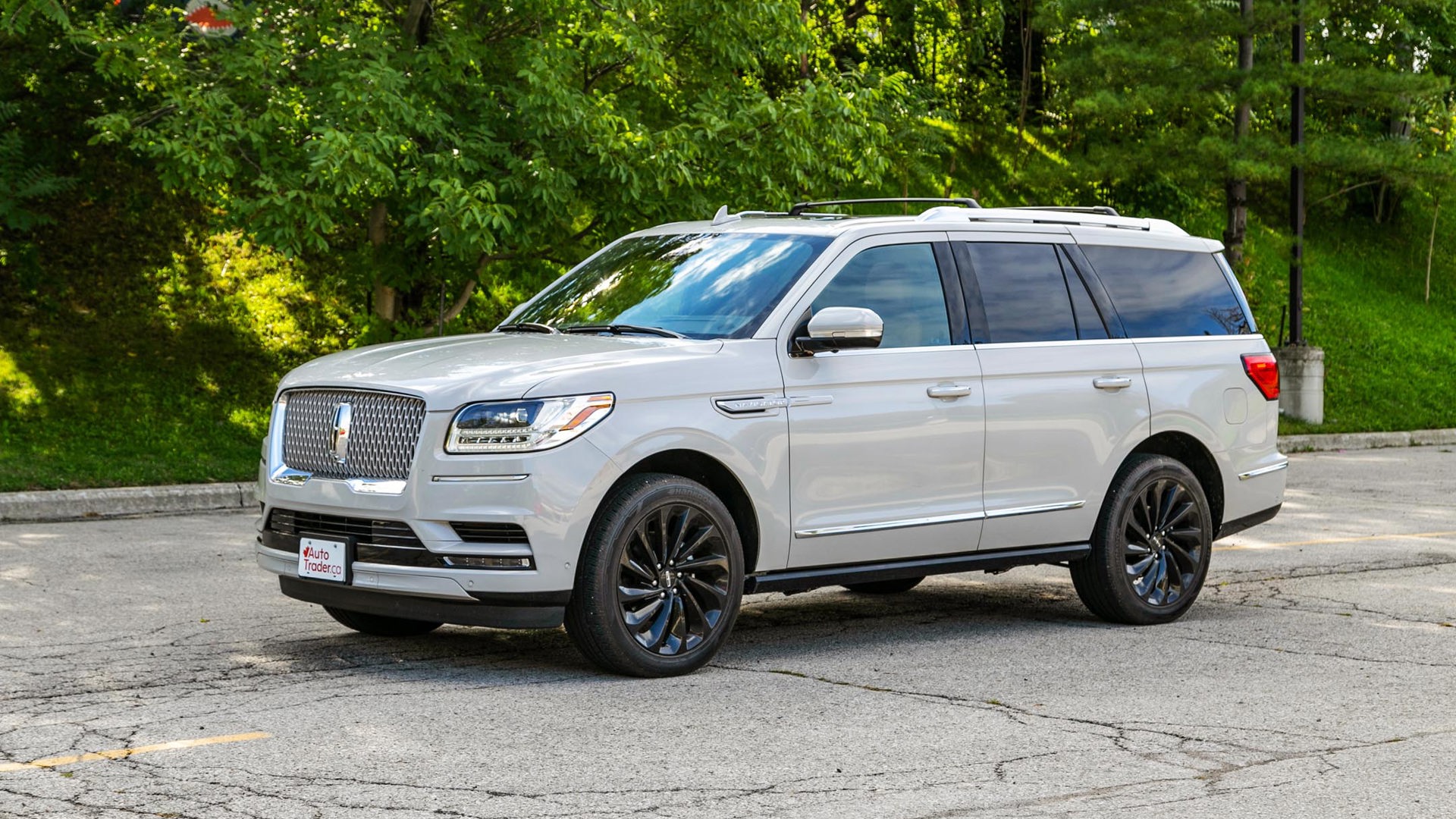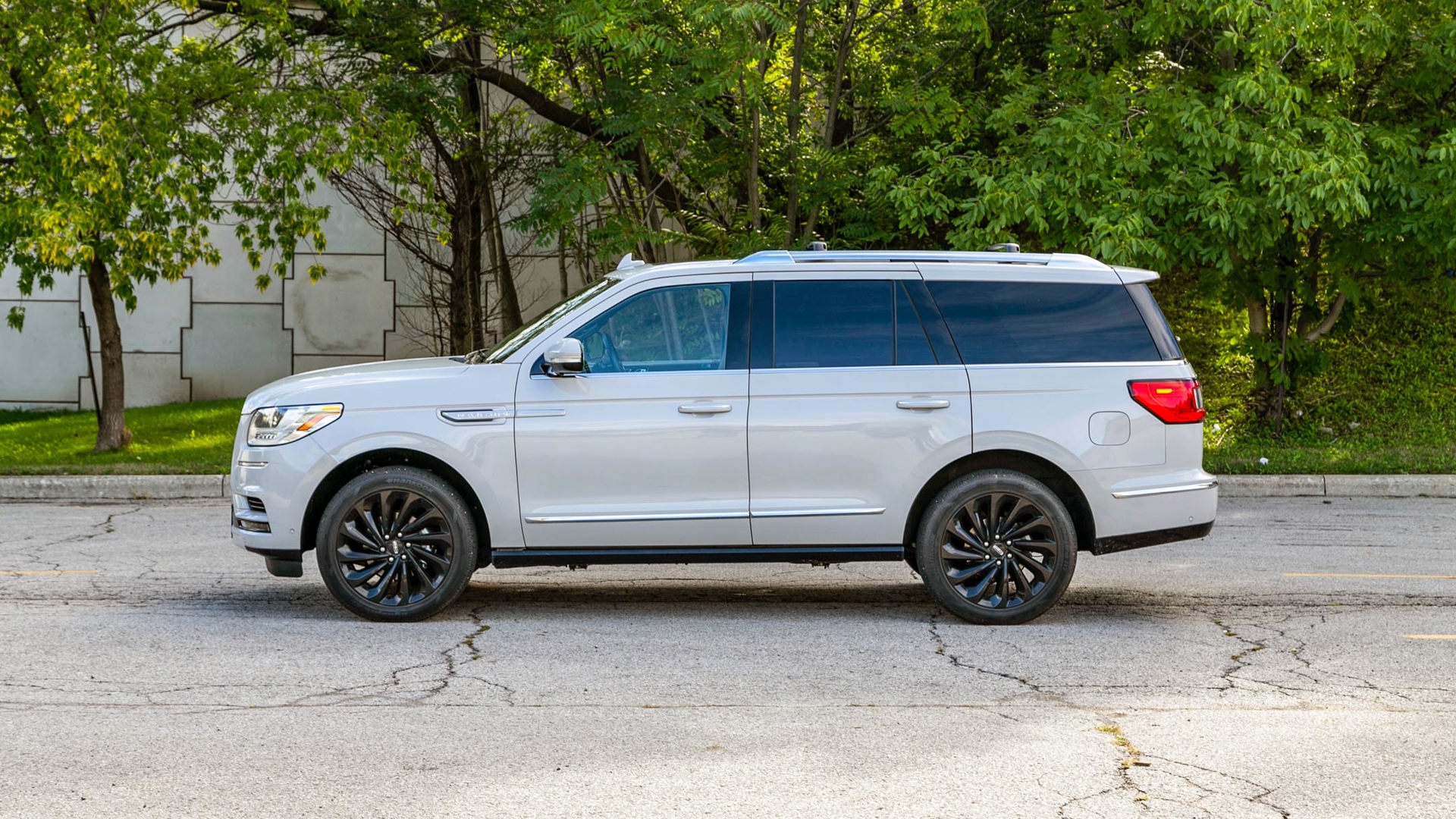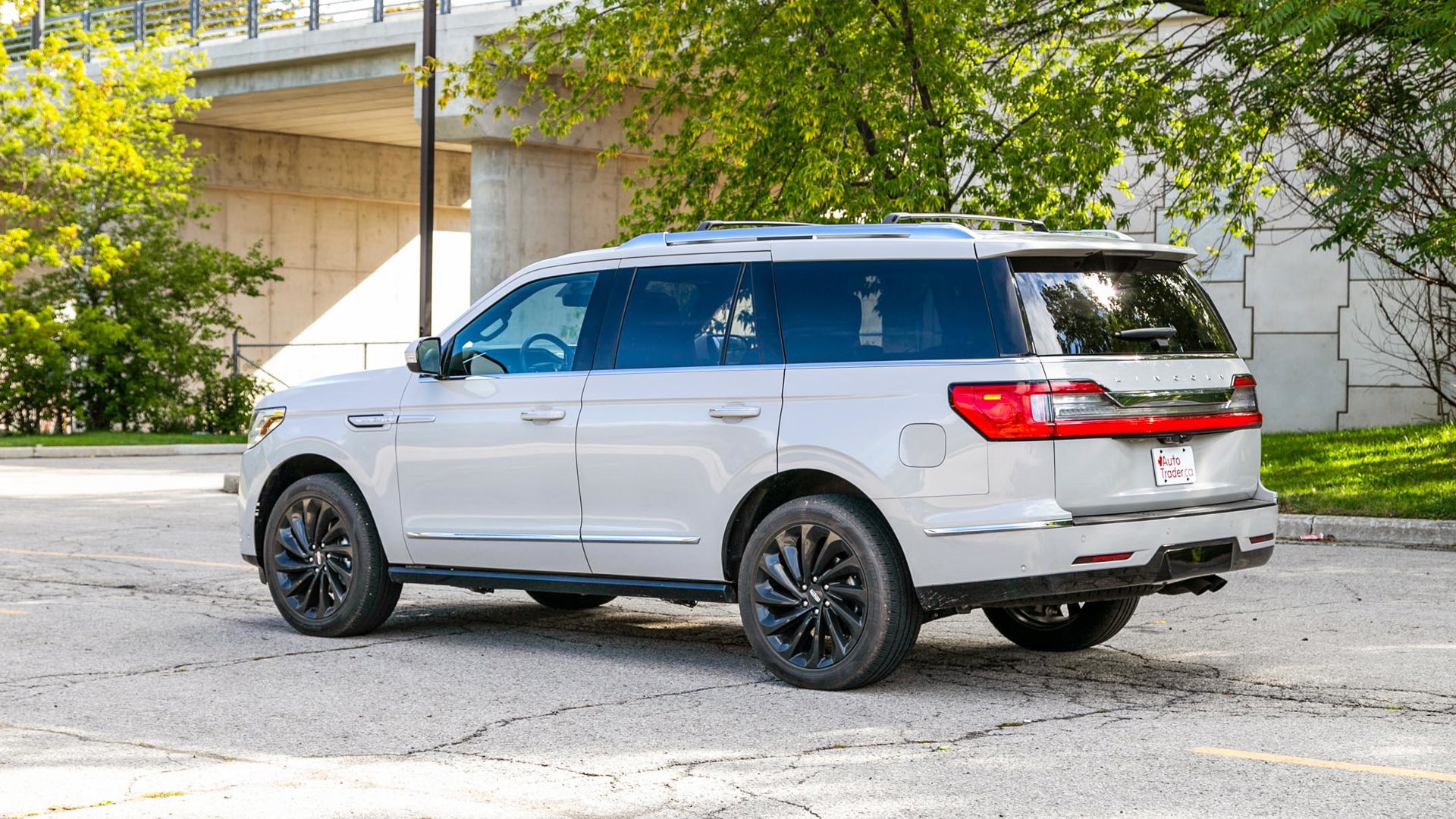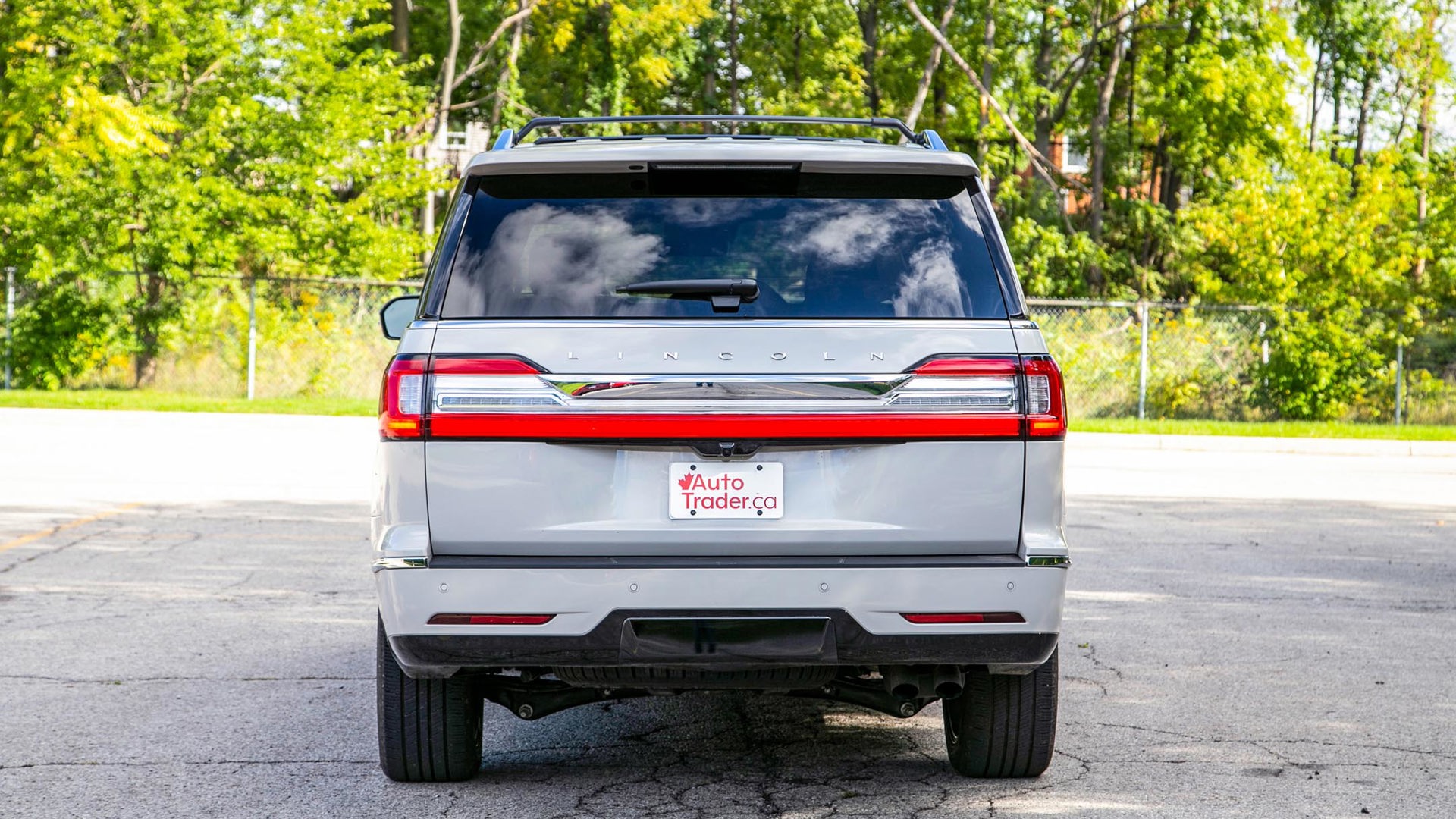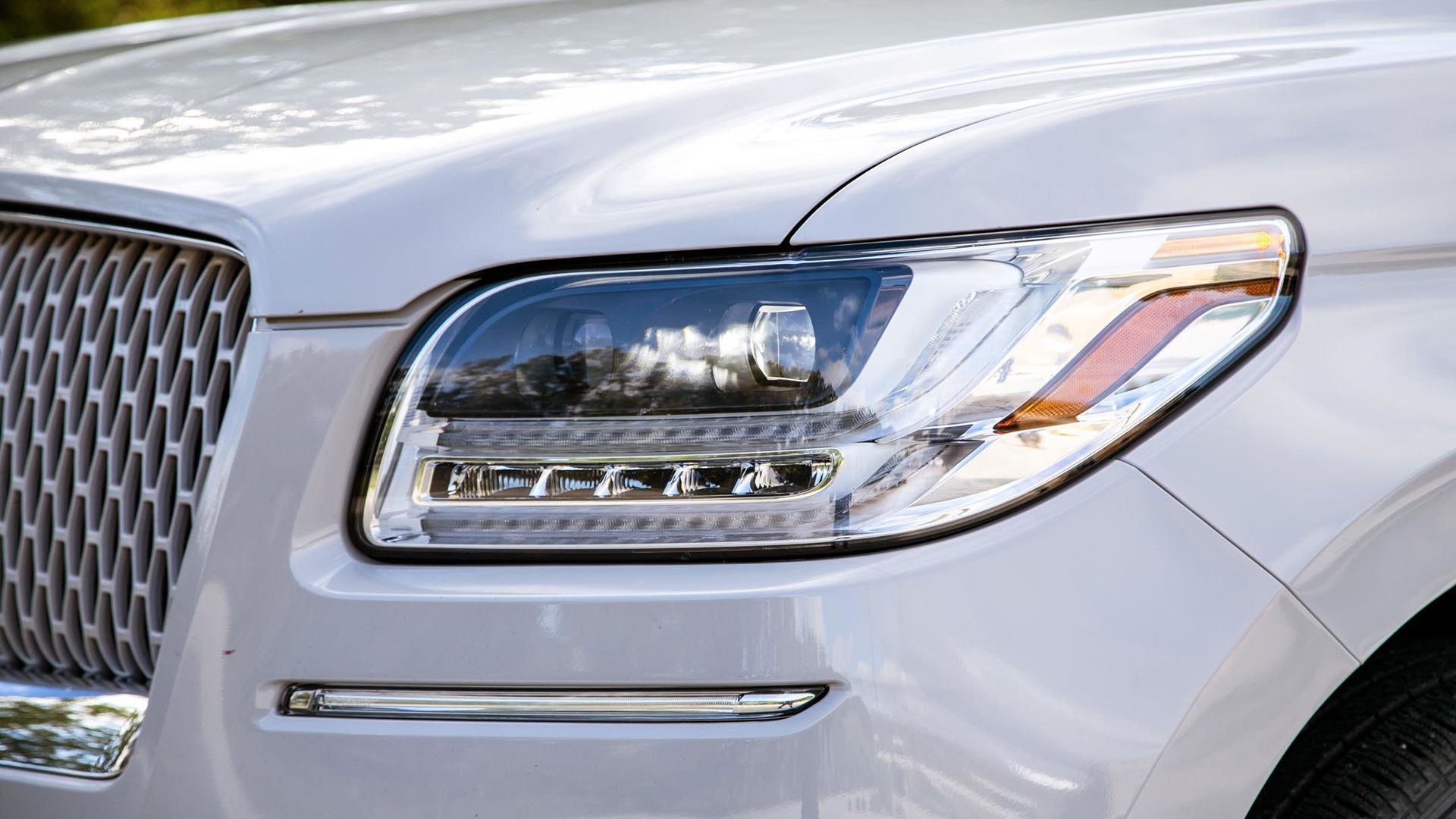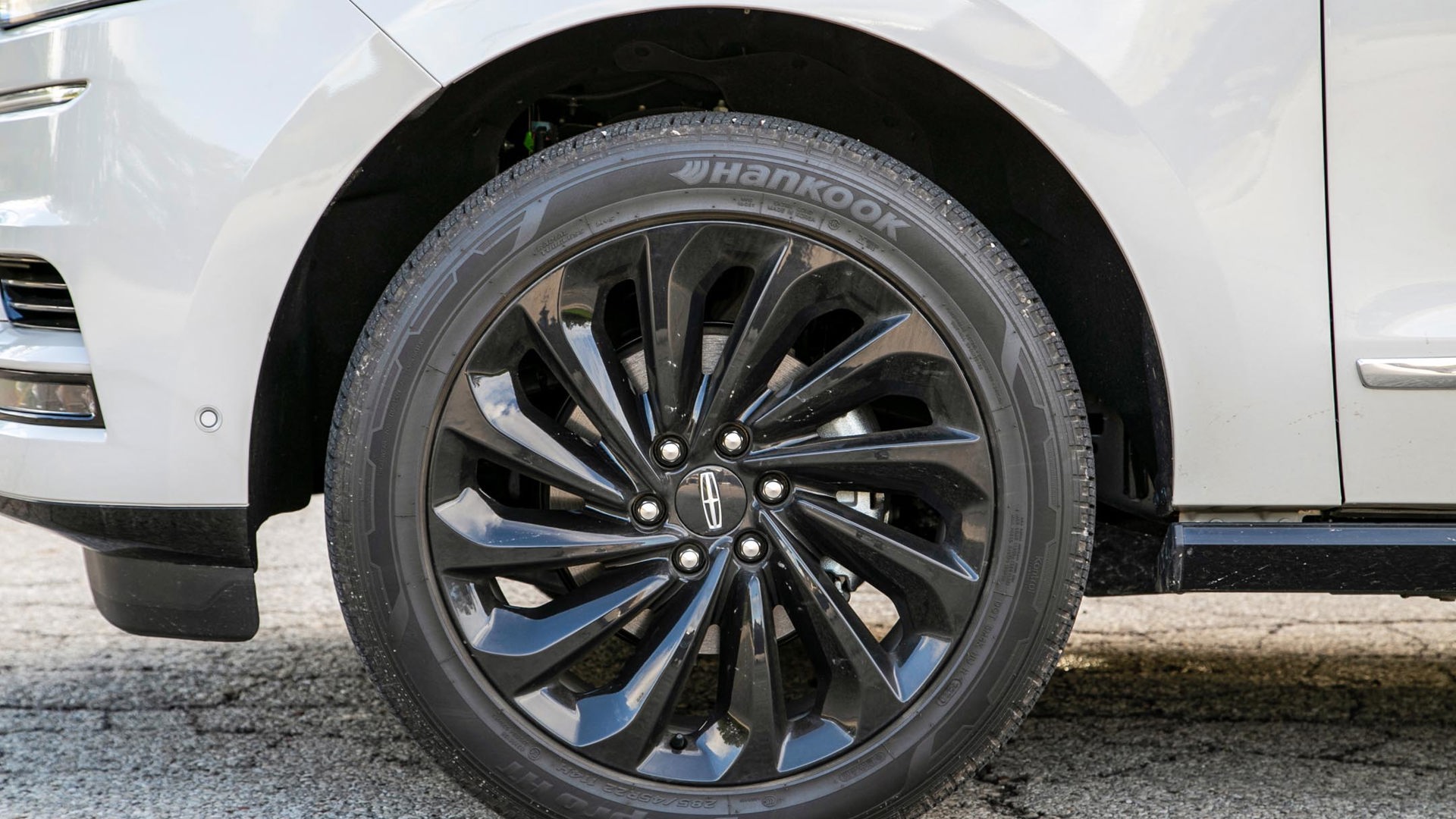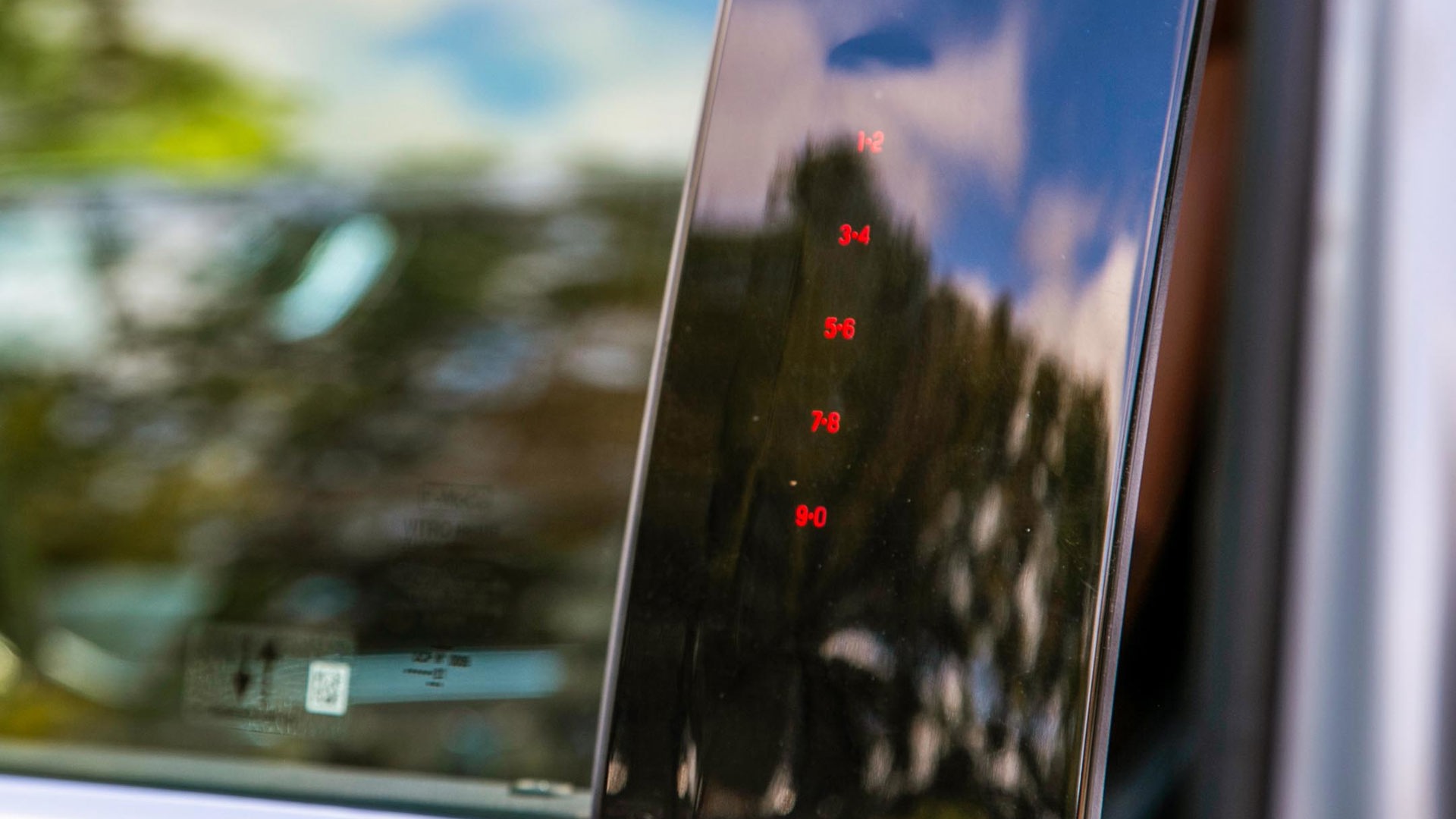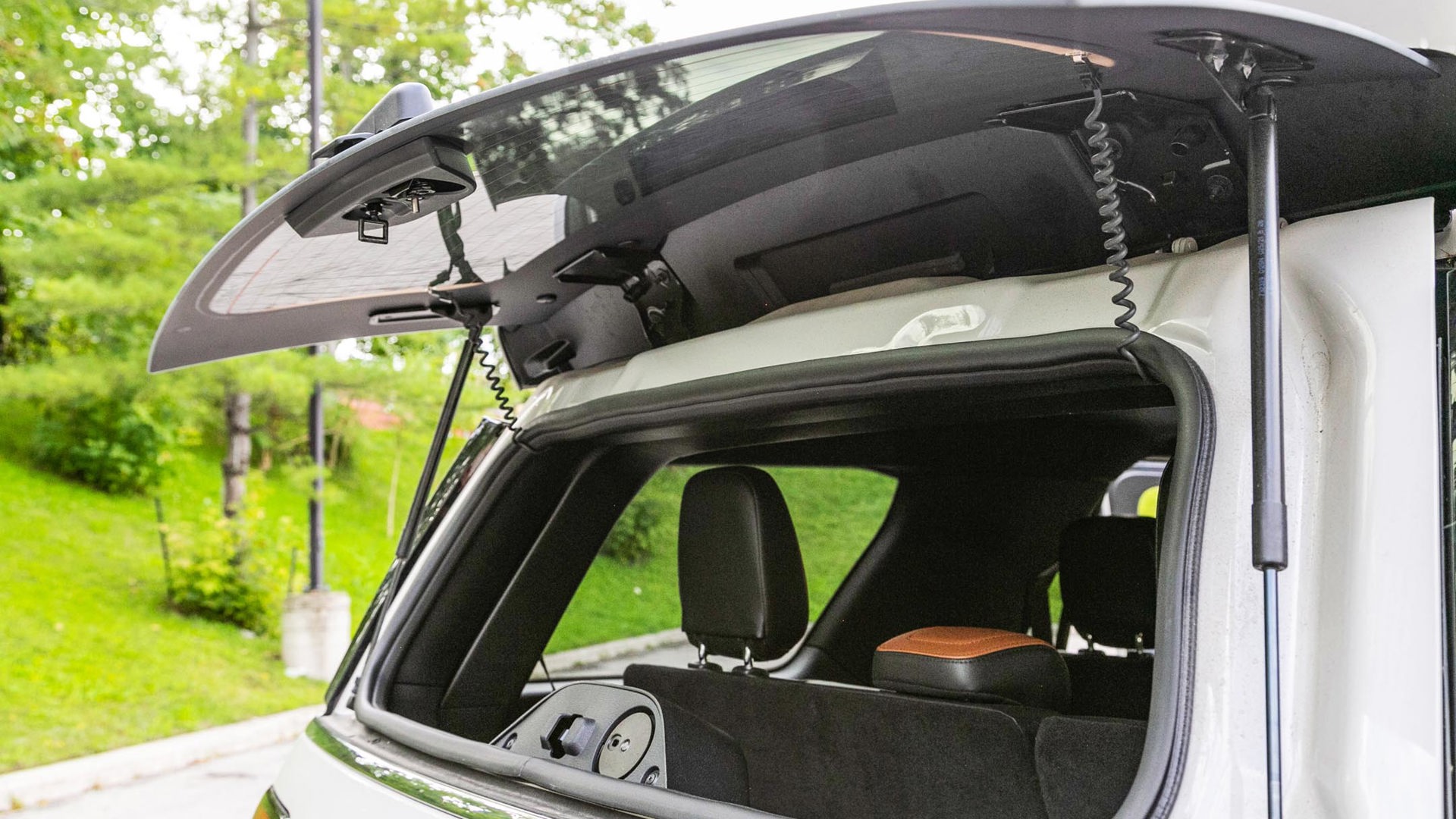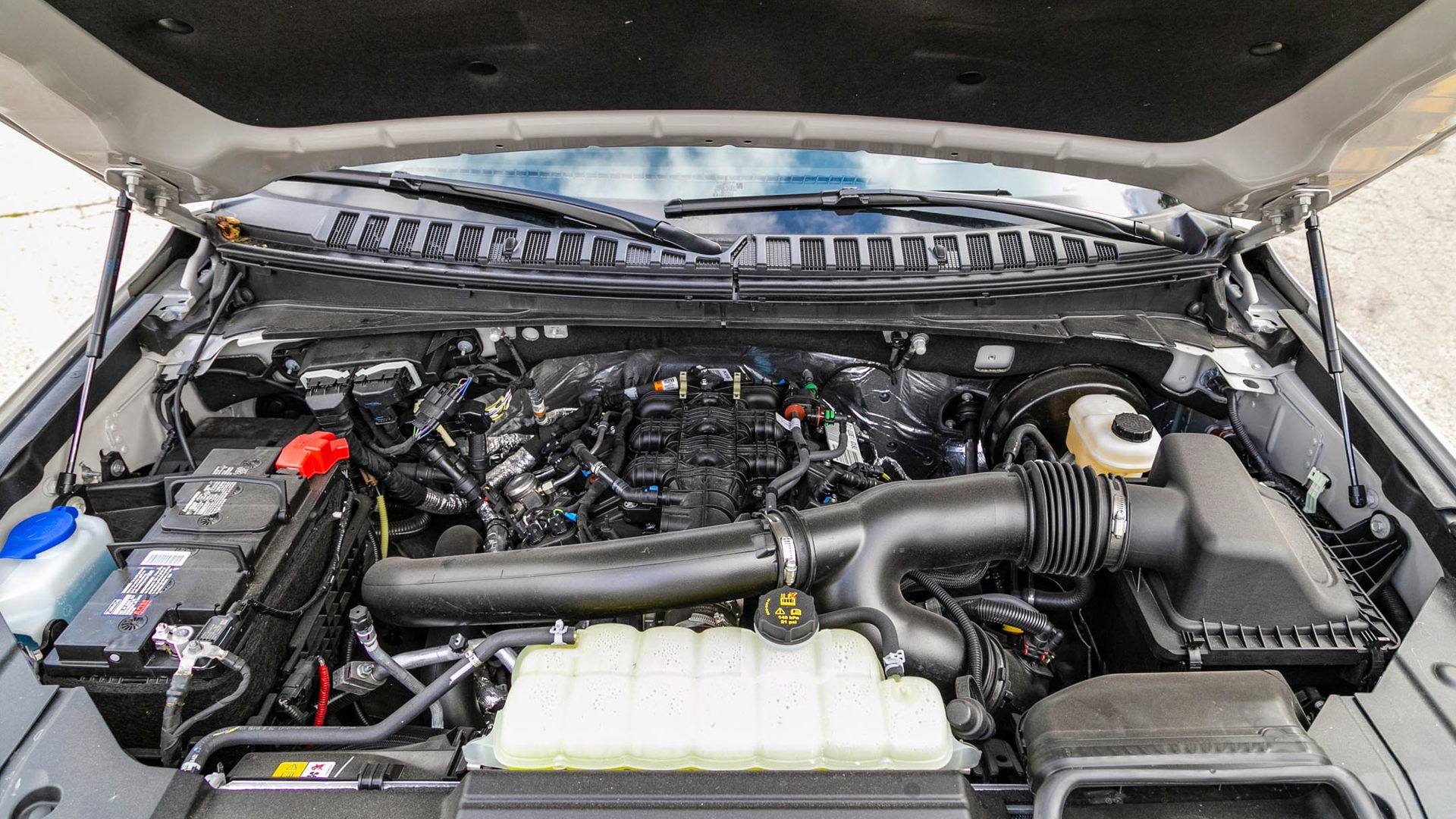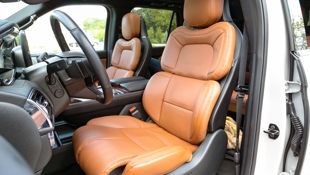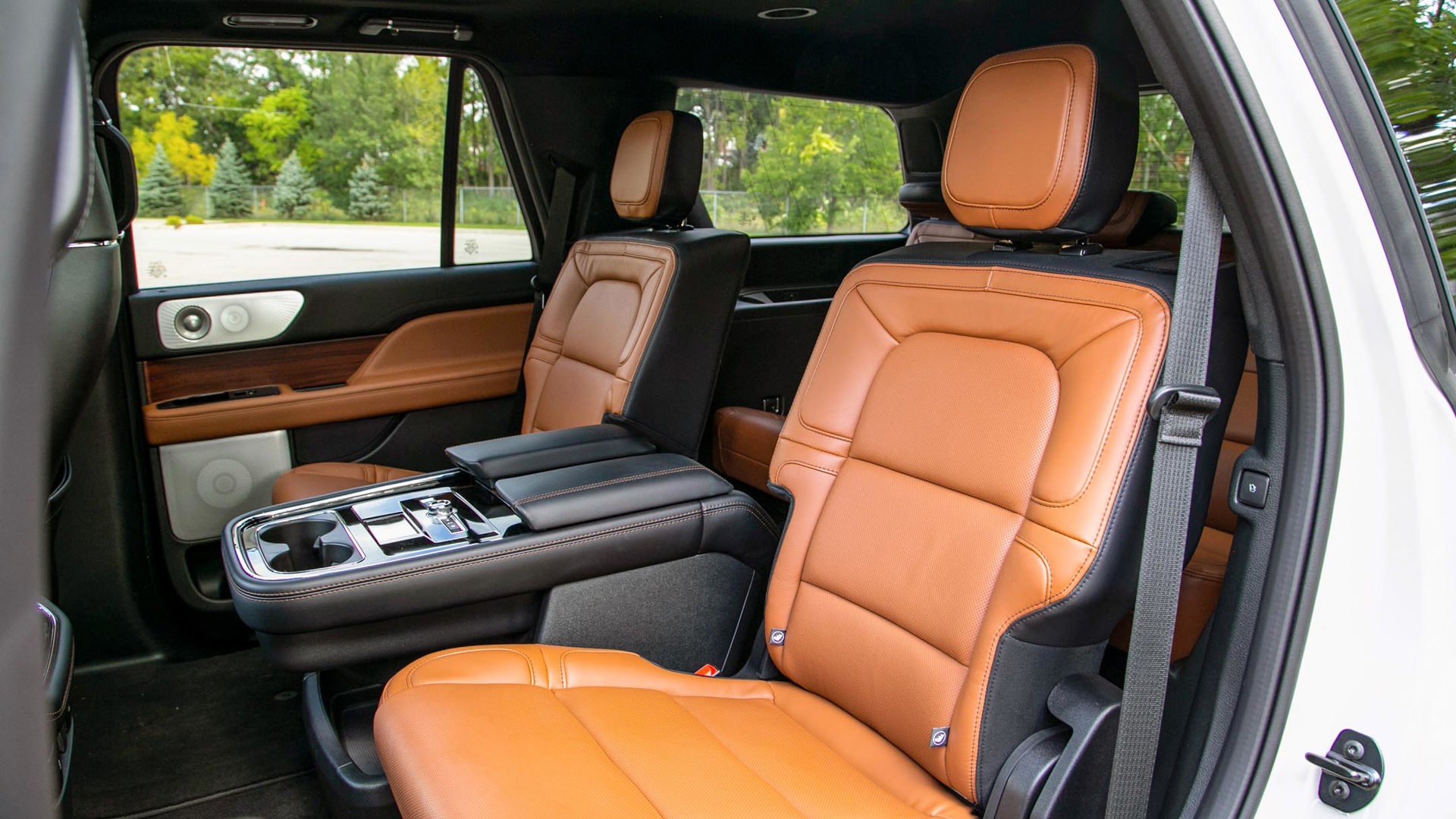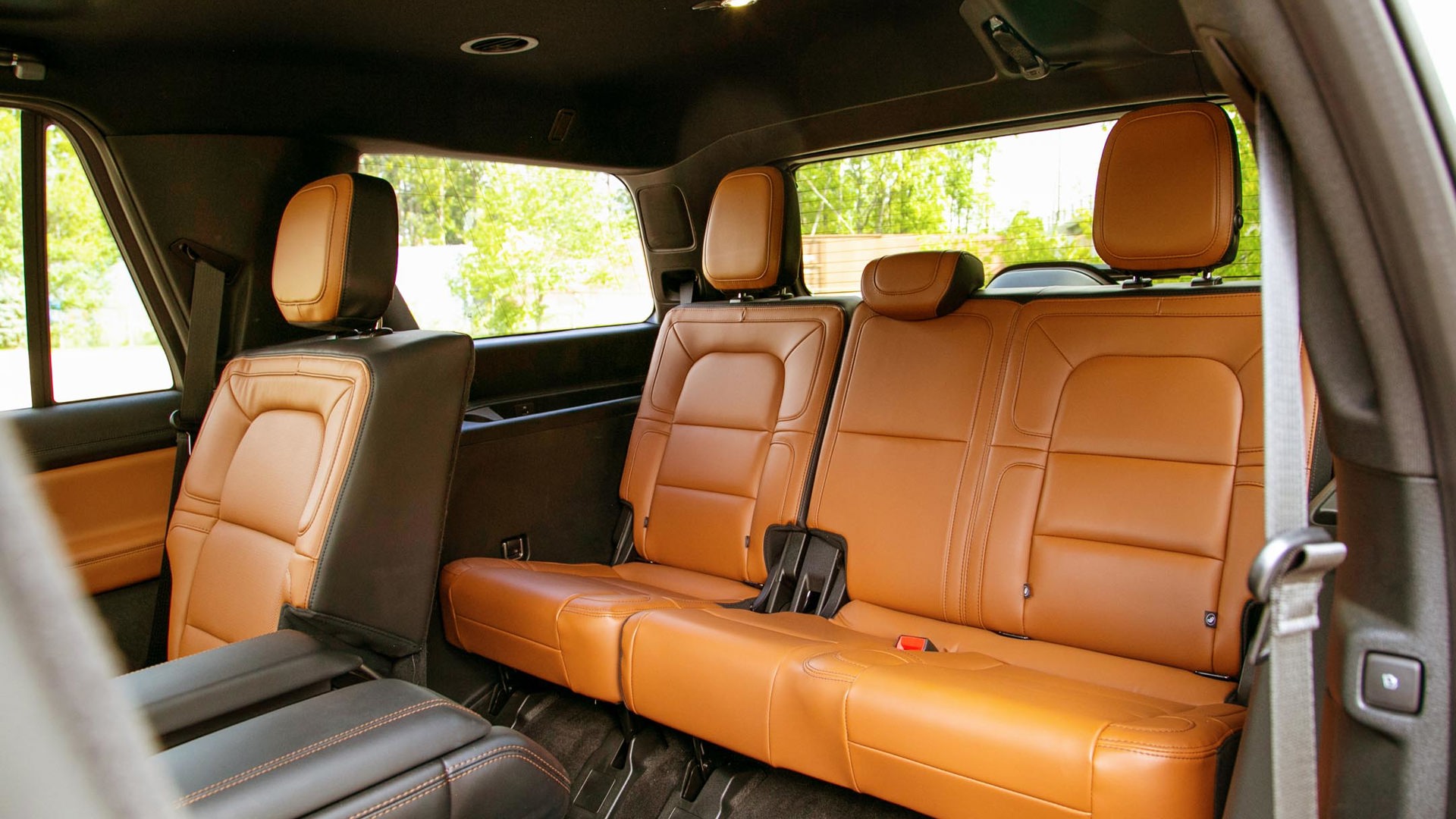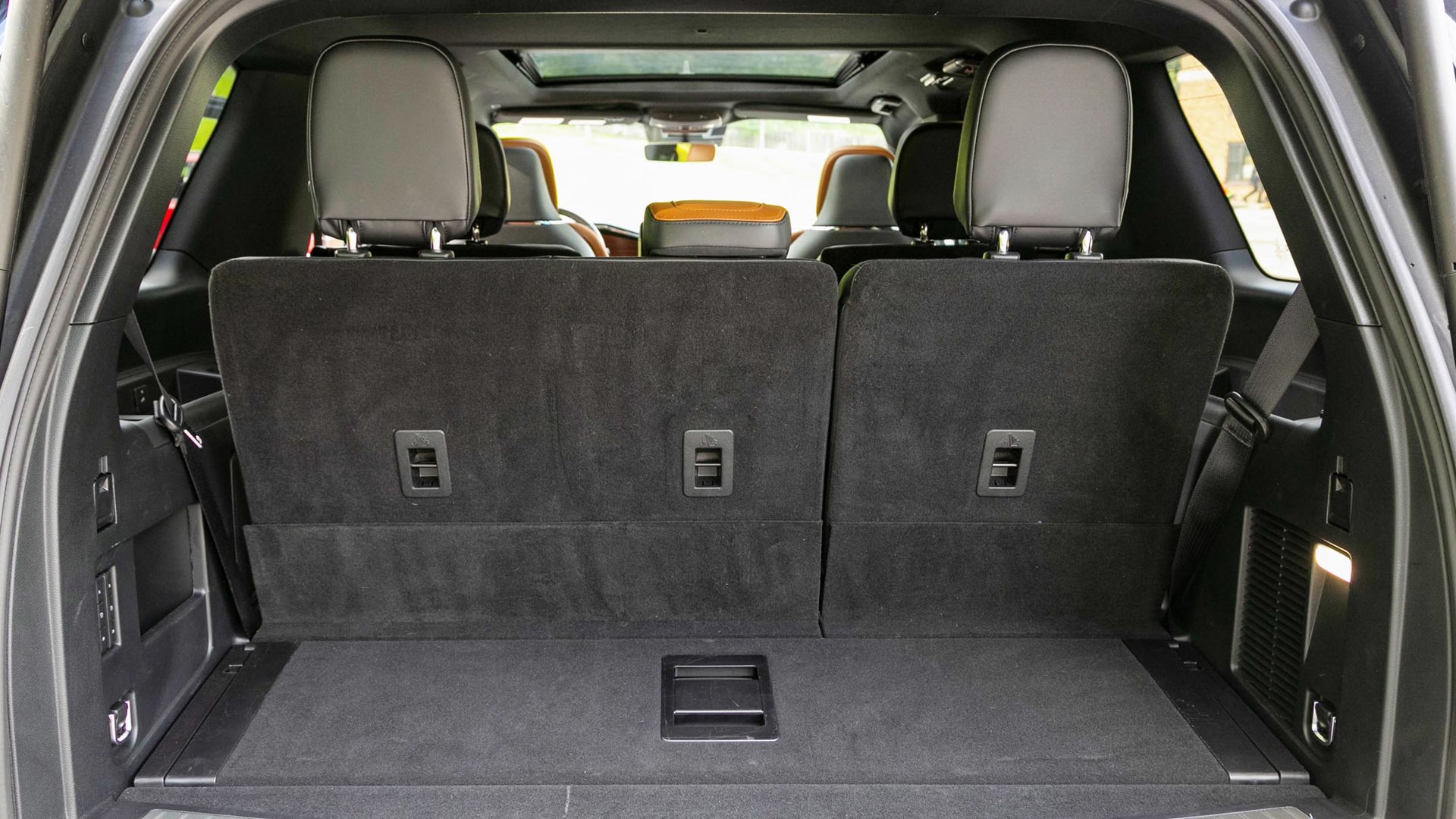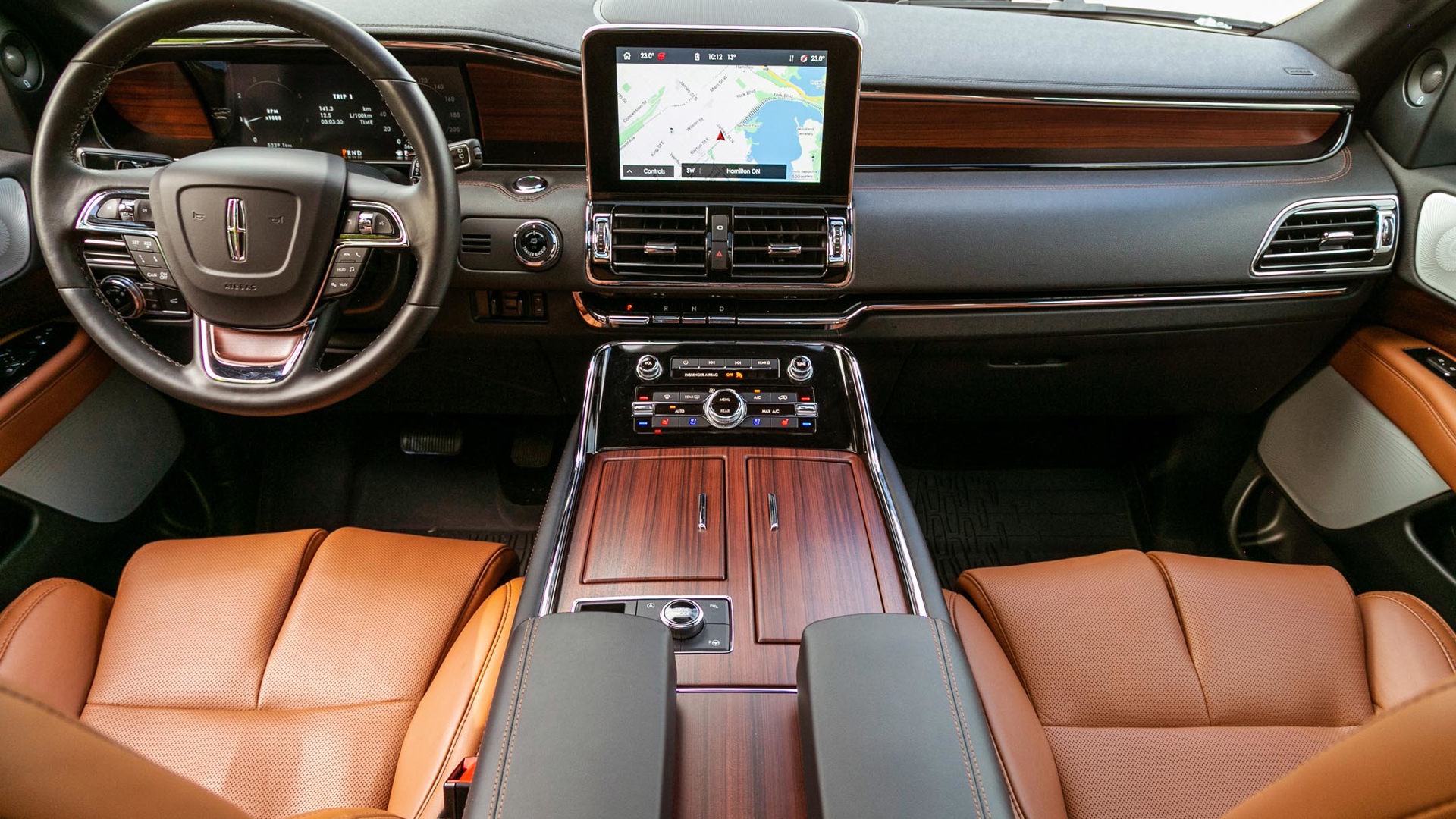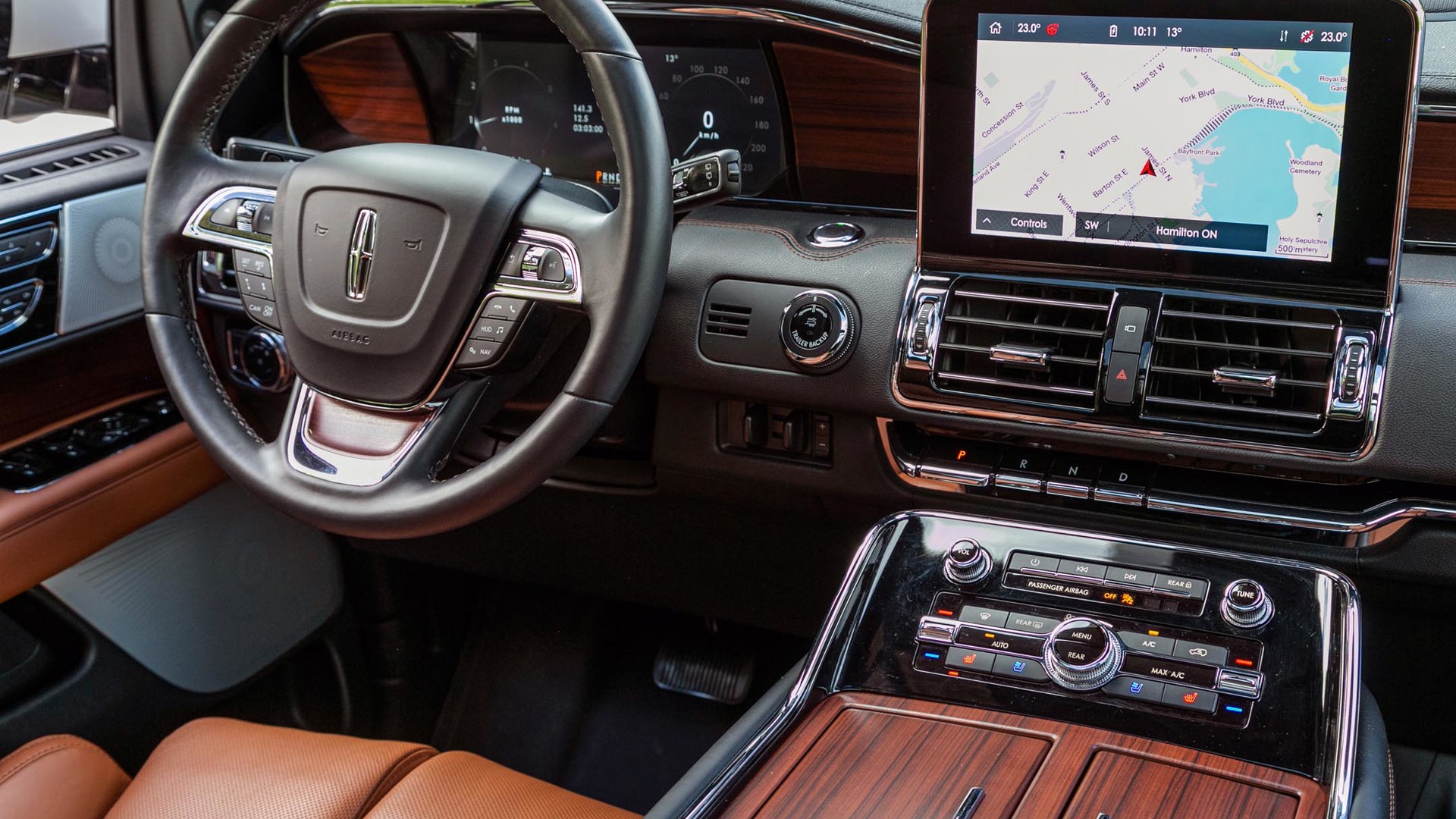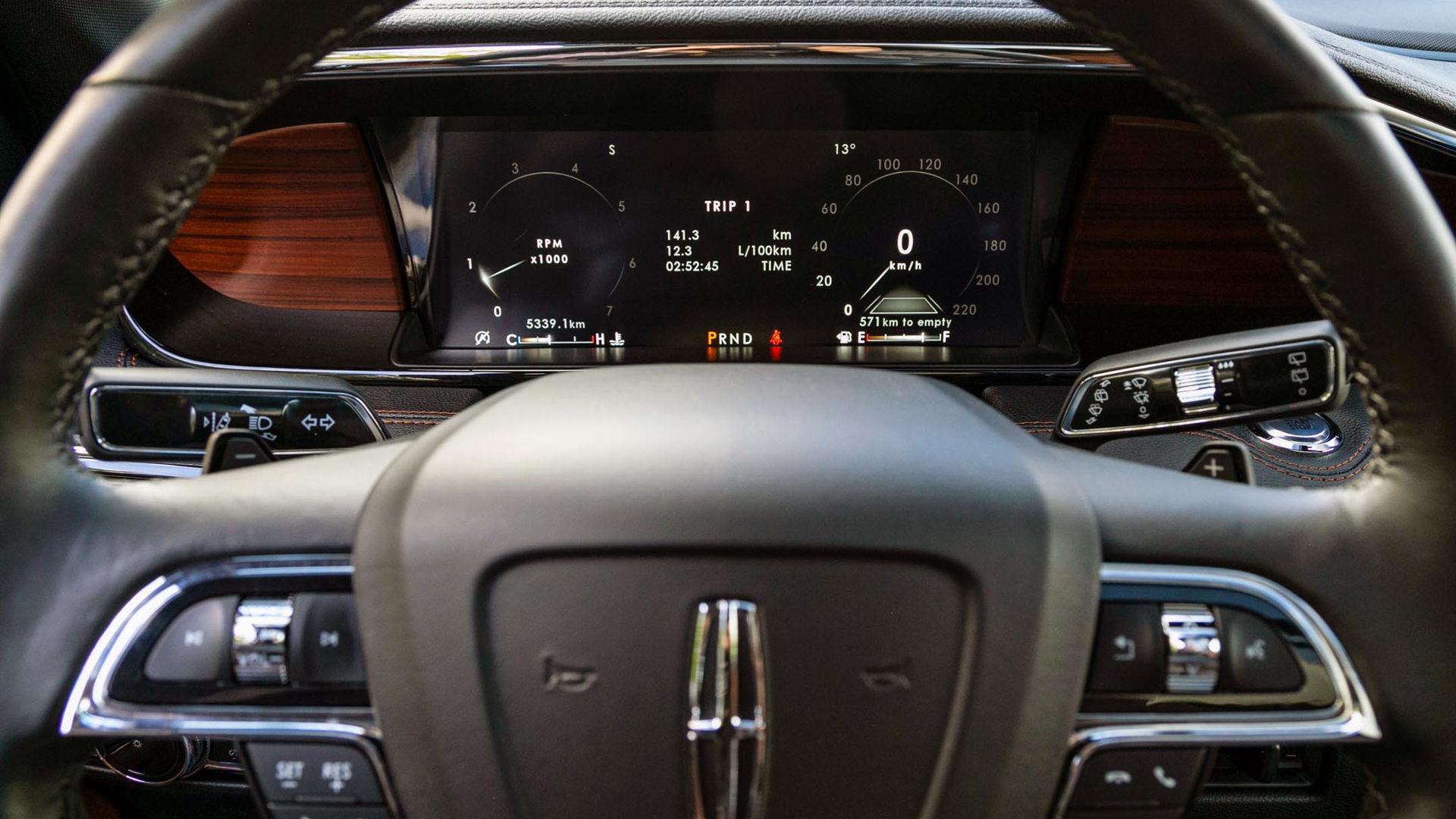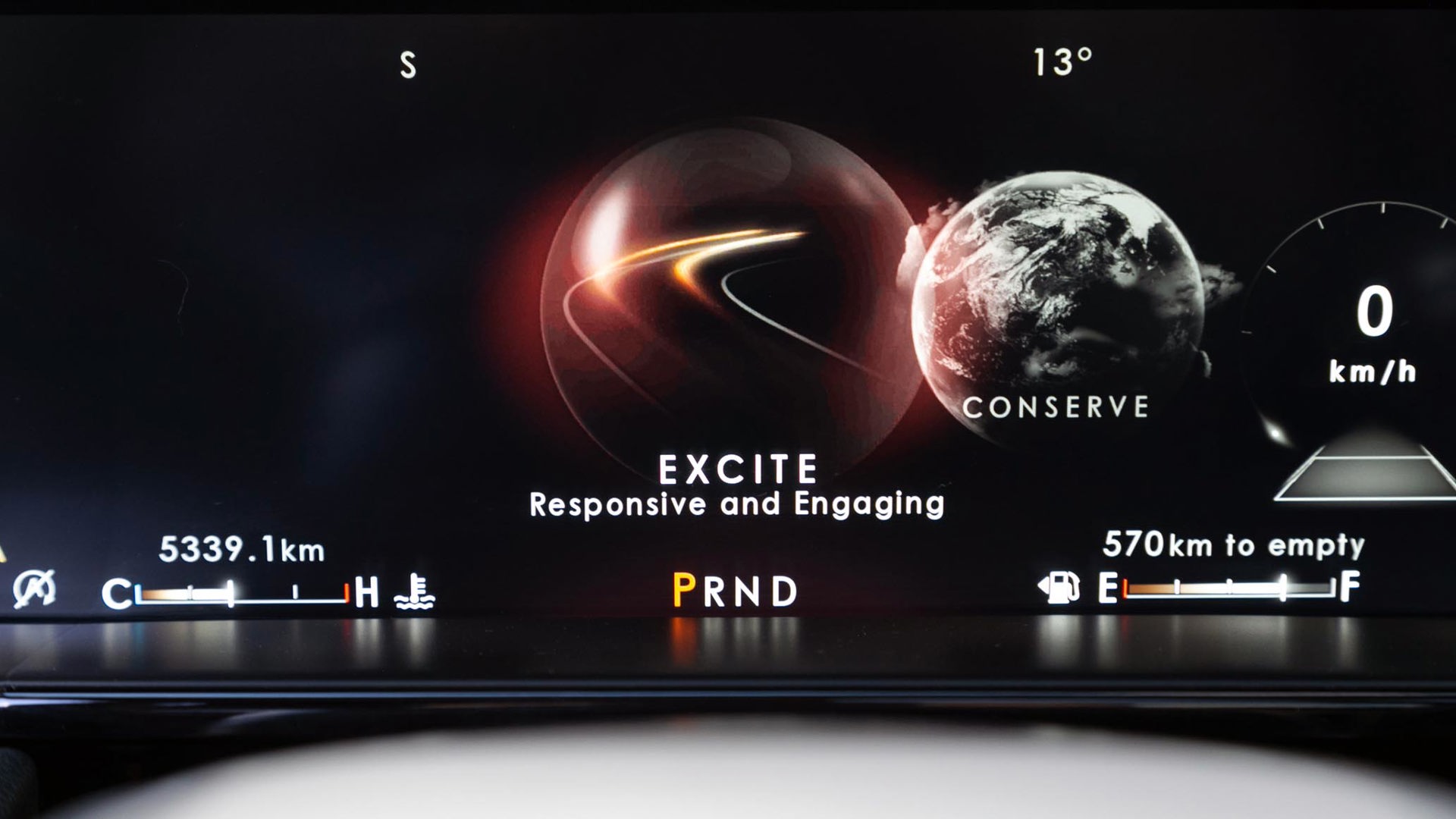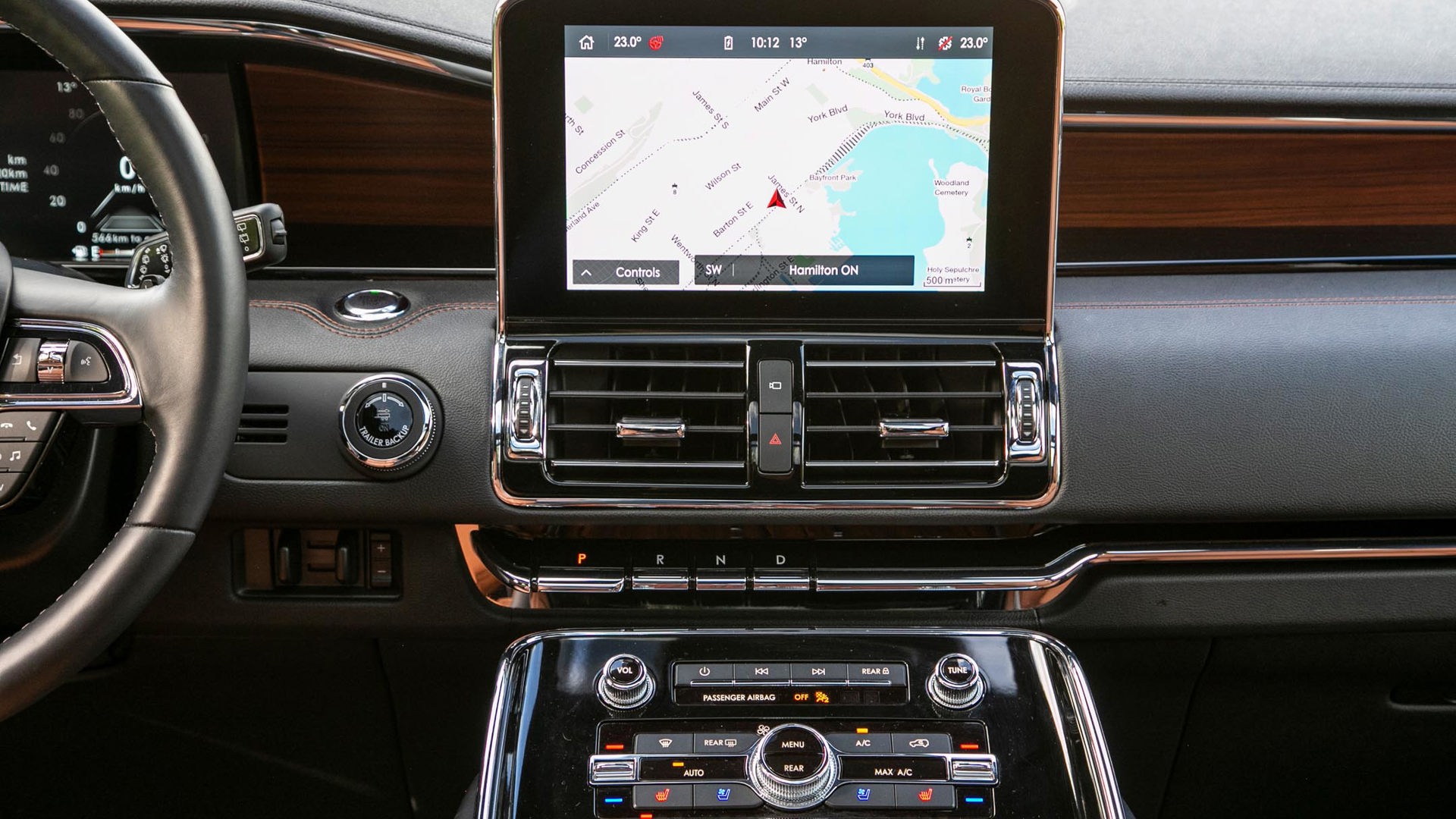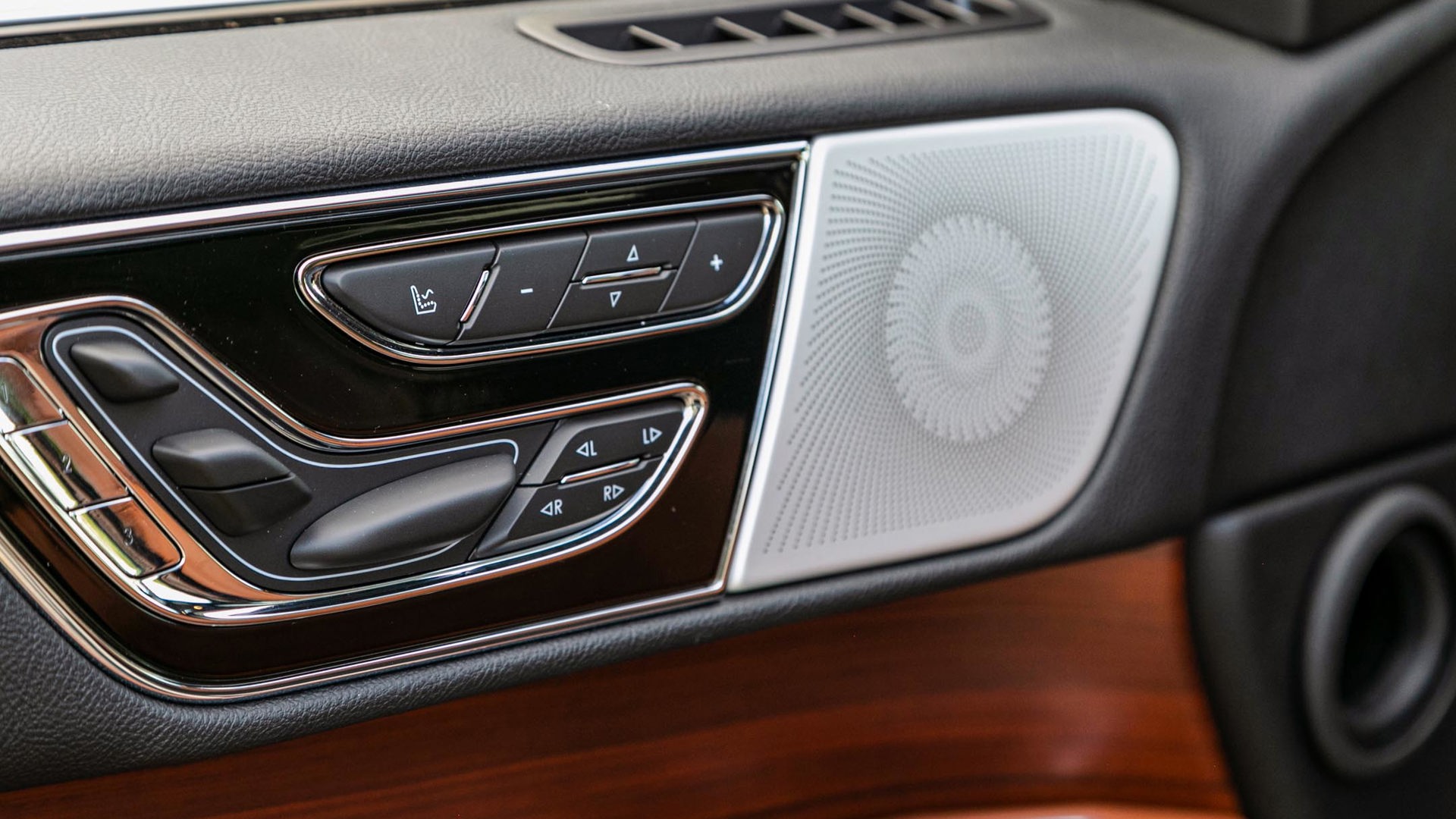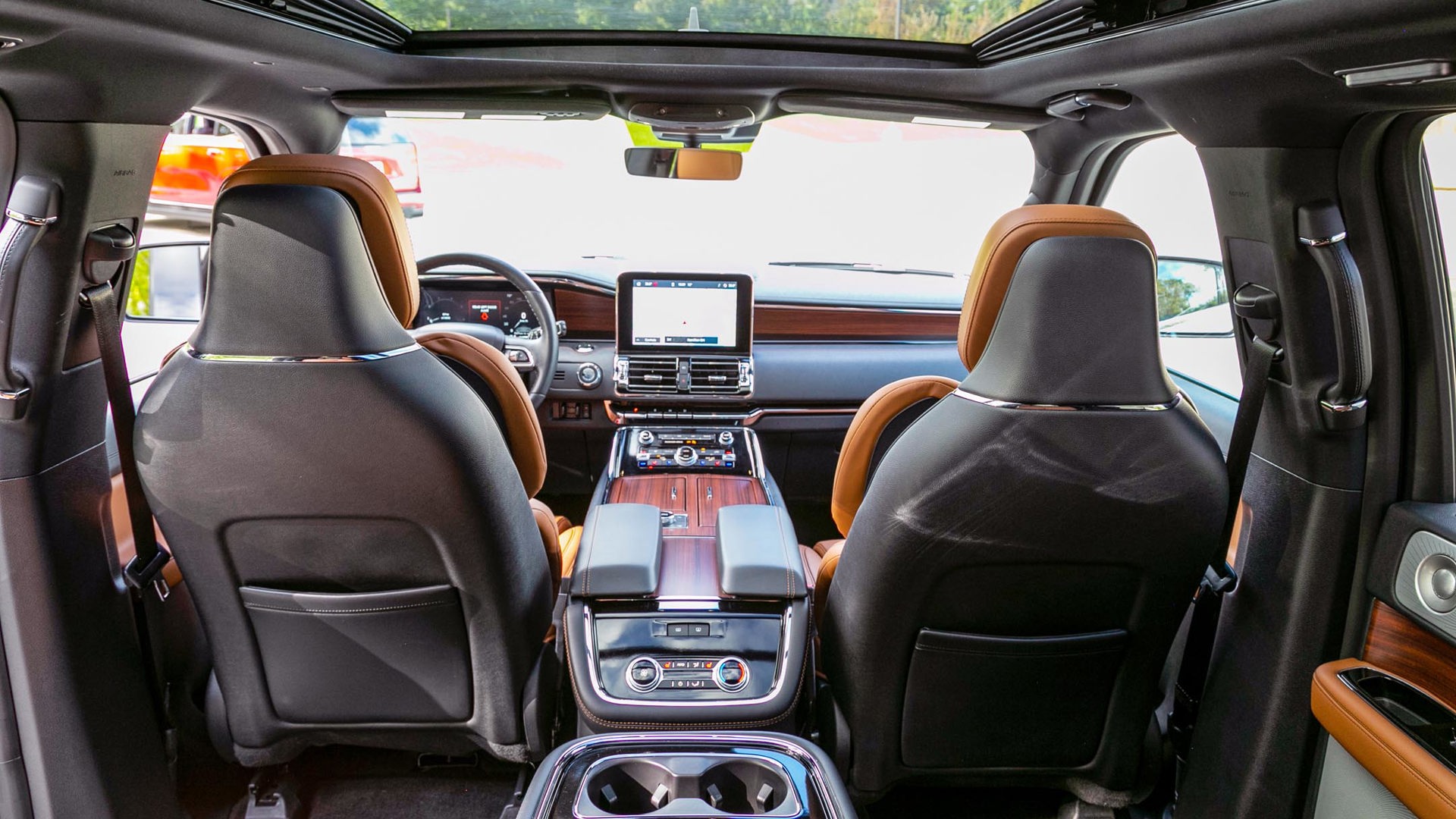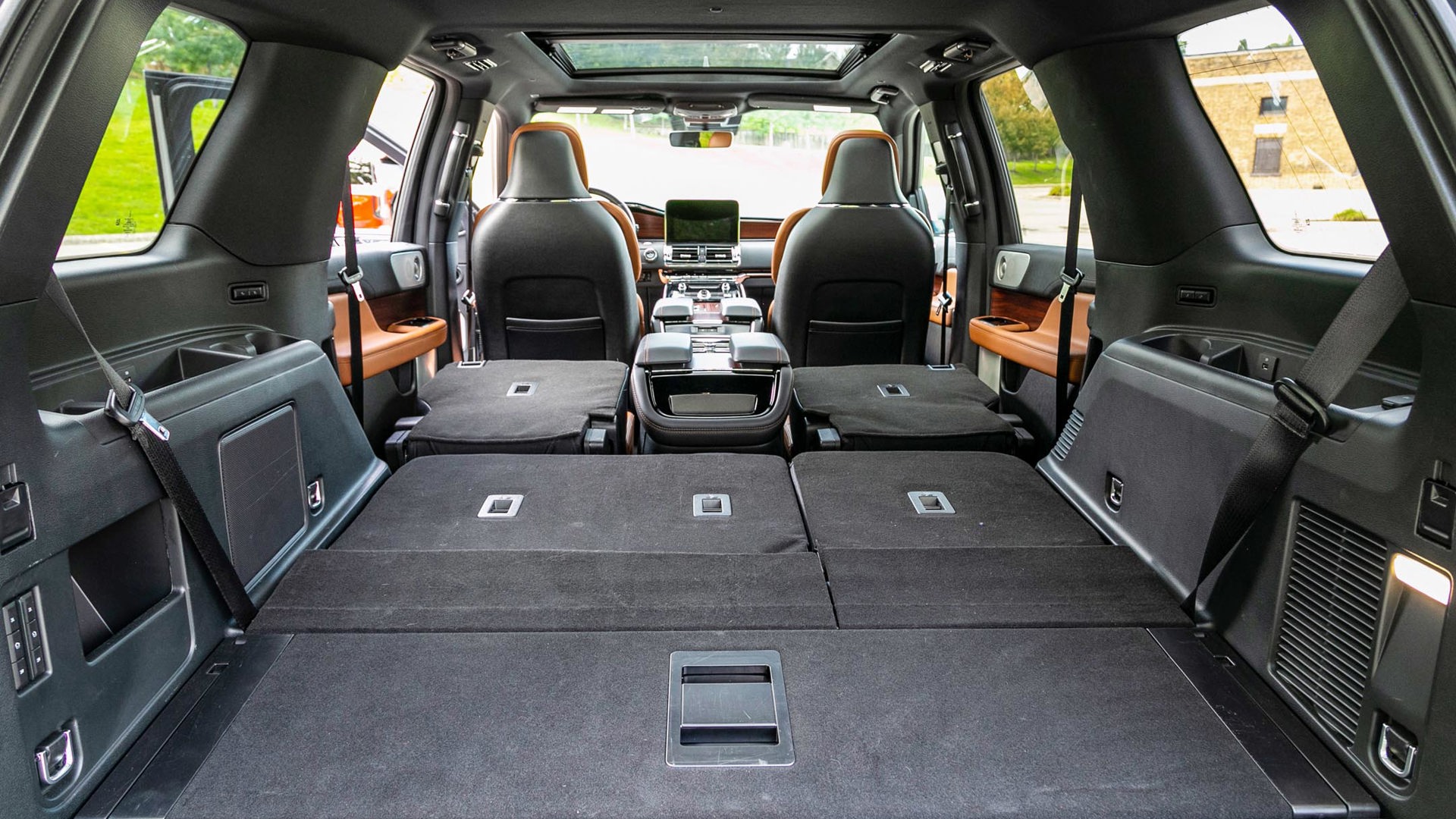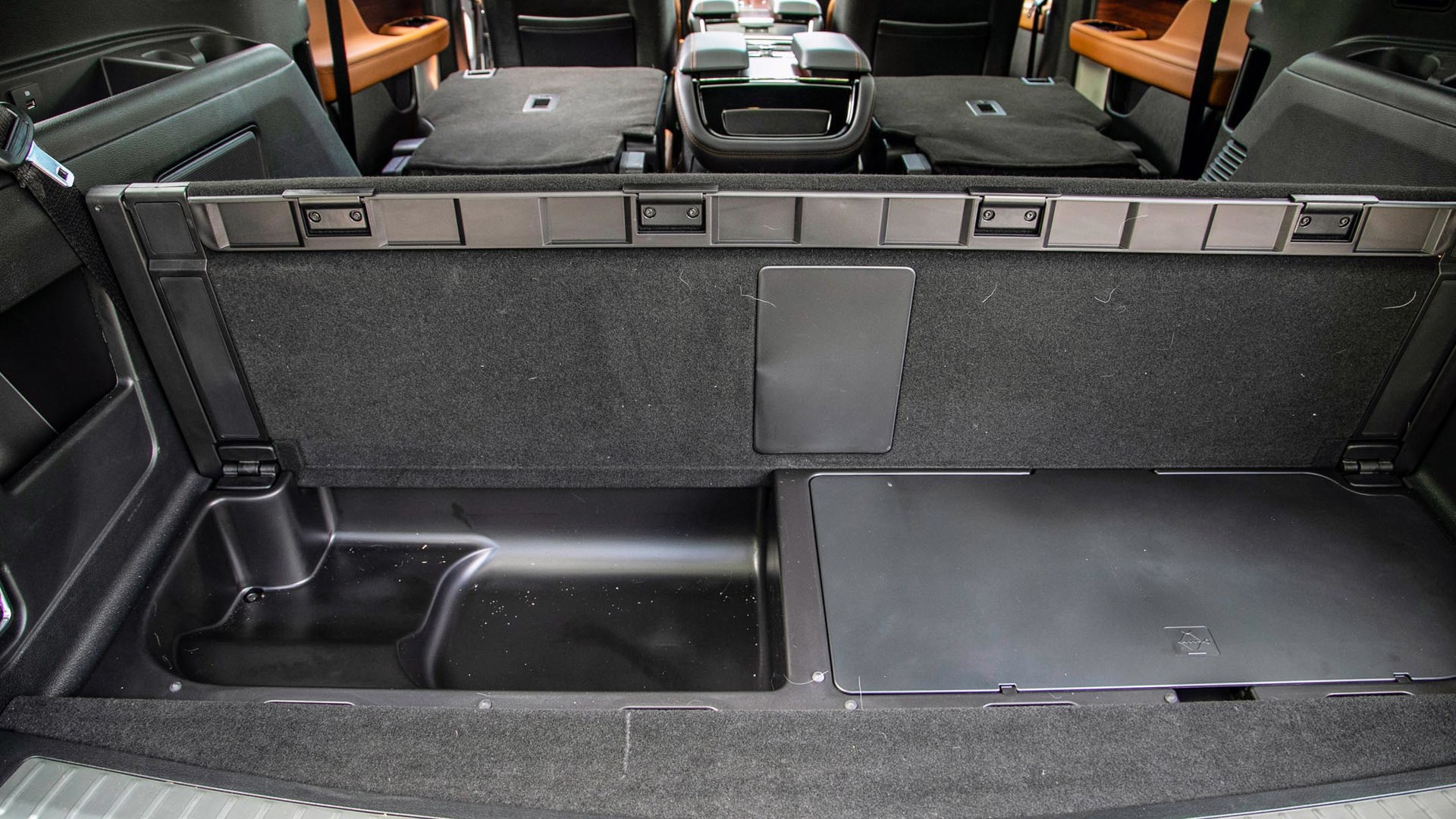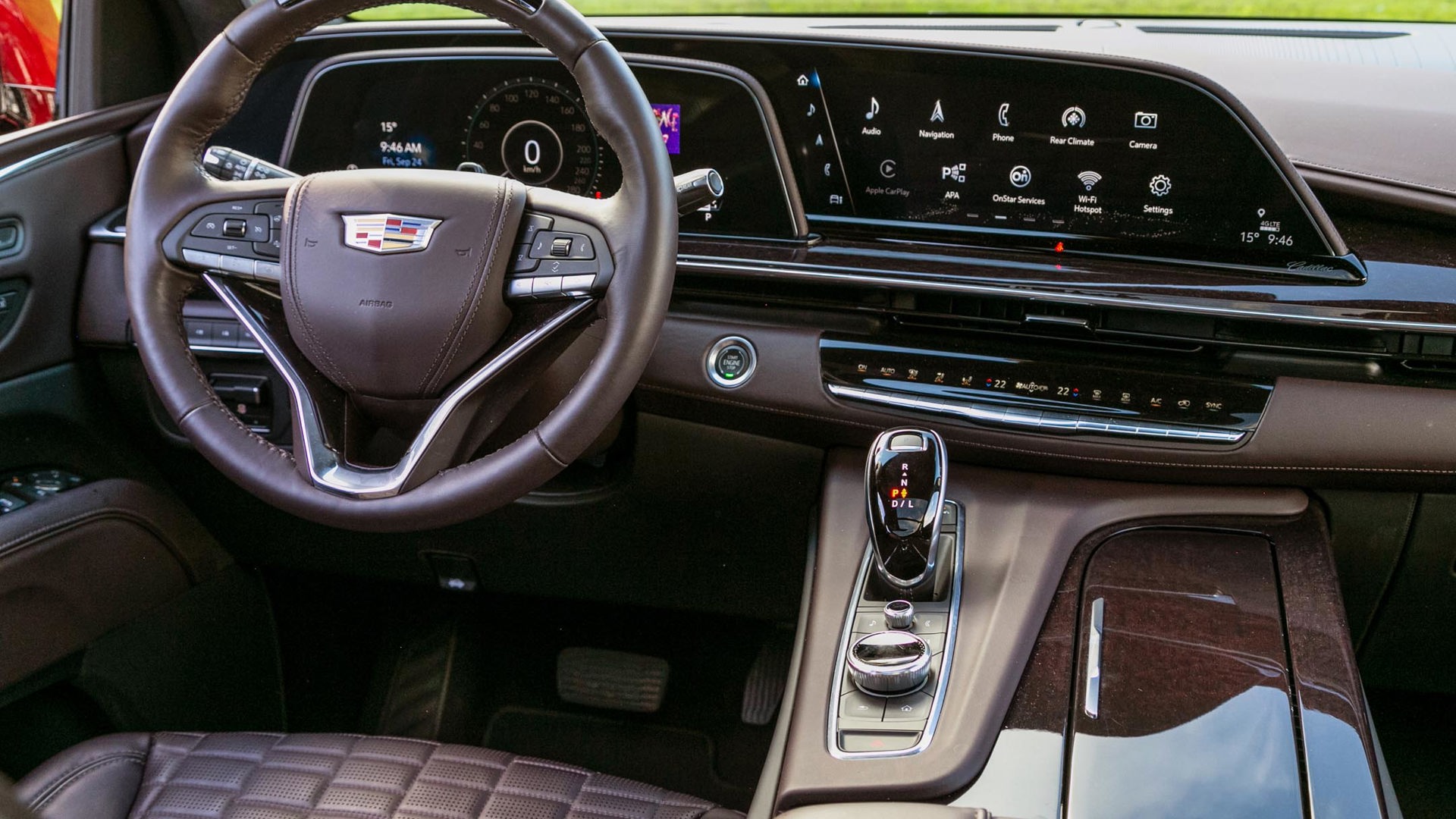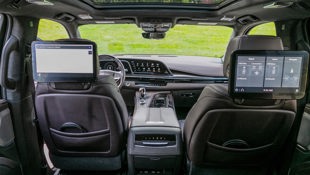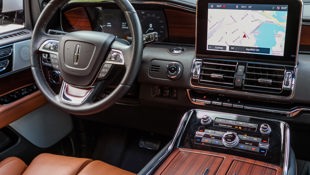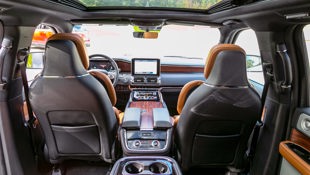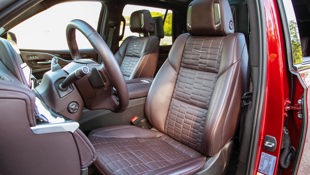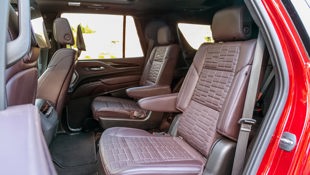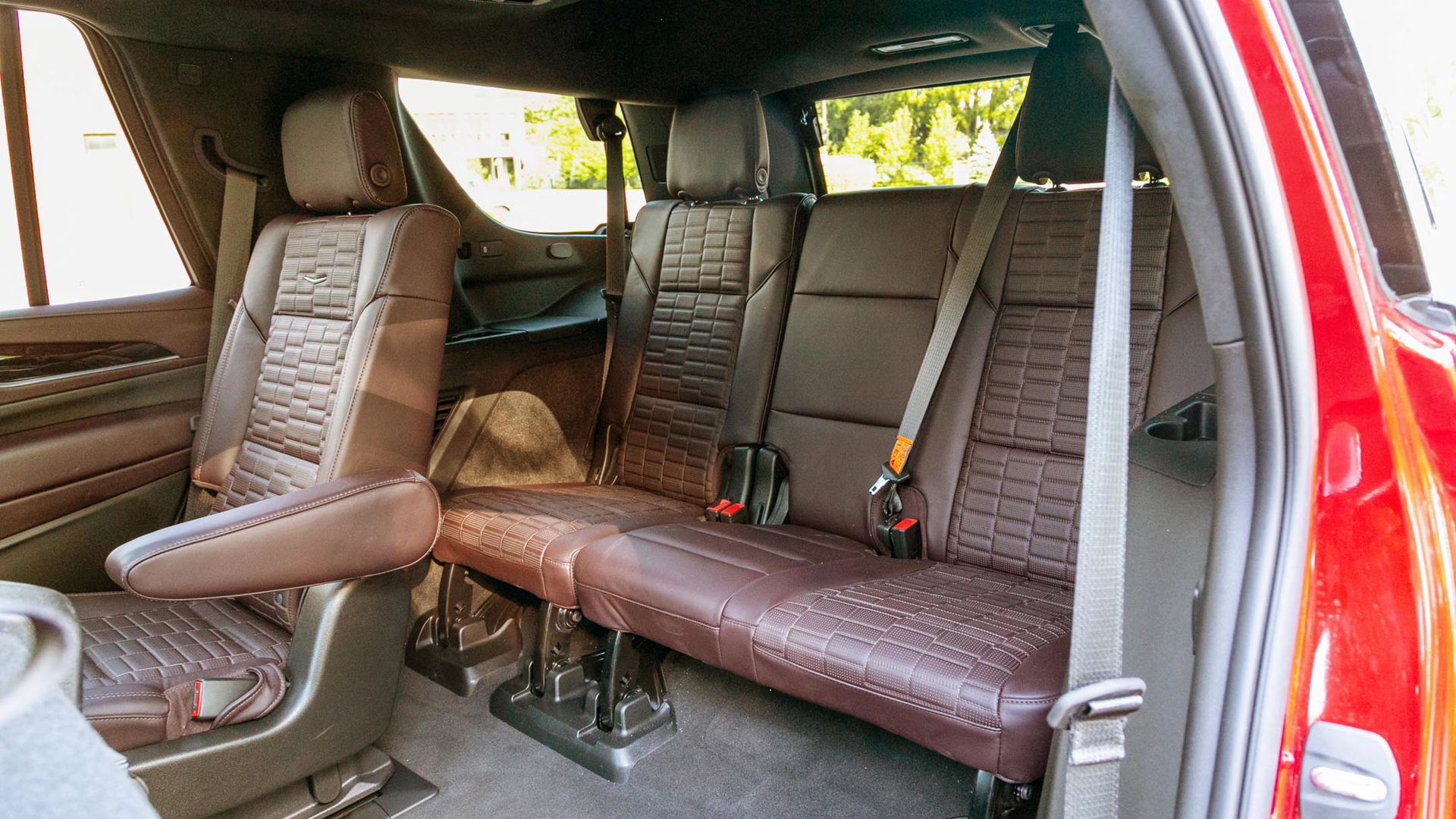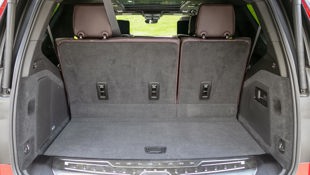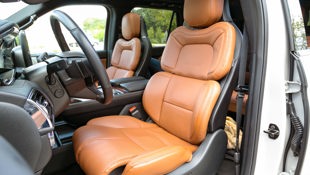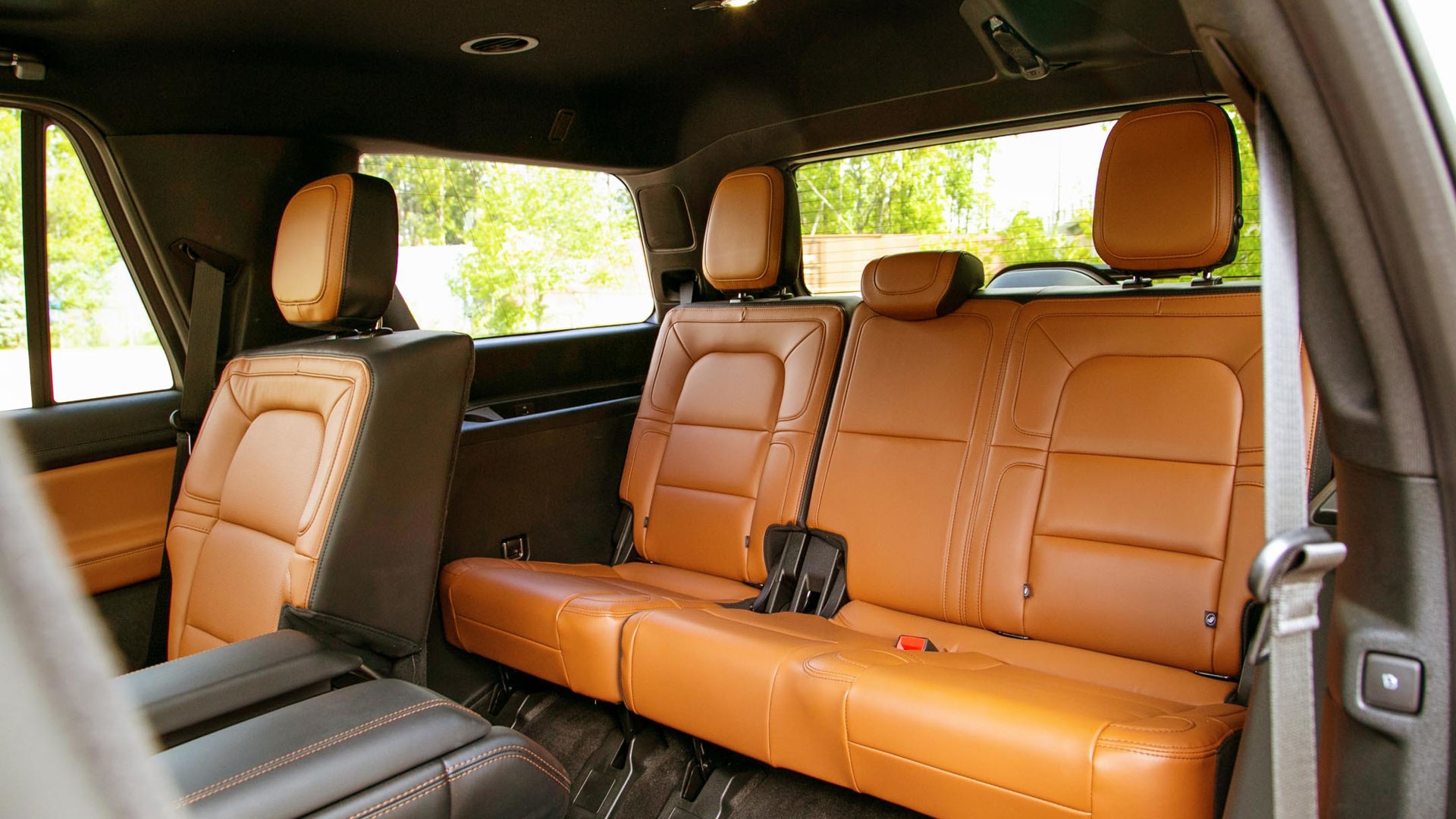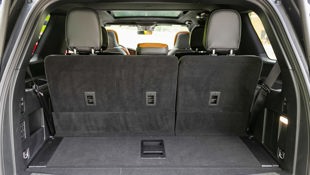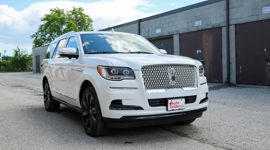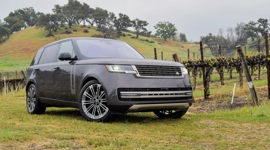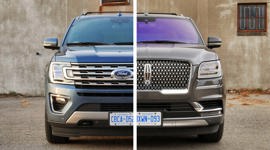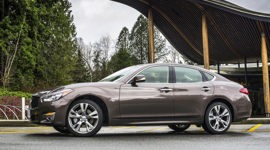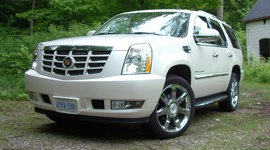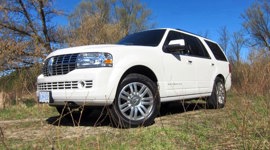Comparison Data
|
2021 Cadillac Escalade 4WD Sport Platinum
|
2021 Lincoln Navigator 4X4 Reserve
|
|---|---|
|
Engine Displacement
6.2L
|
3.5L
|
|
Engine Cylinders
V8
|
V6, twin turbo
|
|
Peak Horsepower
420 hp @ 5,600 rpm
|
450 hp @ 5,500 rpm
|
|
Peak Torque
460 lb-ft @ 4,100 rpm
|
510 lb-ft @ 3,000 rpm
|
|
Fuel Economy
16.8 / 12.4 / 14.8 L/100 km cty/hwy/cmb
|
15.0 / 11.5 / 13.5 L/100 km cty/hwy/cmb
|
|
Cargo Space
722 / 3,427 L seats folded
|
592 / 2,928 L seats folded
|
|
Base Price
$117,798
|
$96,500
|
|
A/C Tax
$100
|
$100
|
|
Destination Fee
$2,100
|
$2,150
|
|
Price as Tested
$137,138
|
$109,150
|
|
Optional Equipment
$17,140 – Onyx Package, $4,885; Performance Upgrade Package, $3,535; Super Cruise, $2,875; Night Vision, $2,300; Infrared Tintcoat Paint, $1,395; Cooled Console, $805; Heavy-duty Trailer Package, $760; Illuminated Liftgate Sill Plate, $585
|
$10,400 – Monochromatic Package, $2,250; Ceramic Pearl Metallic Tri-Coat Paint, $900; Heavy Duty Trailering Package, $750; Cargo Convenience Package, $500; Luxury Package, $3,250; 2nd Row Captain Chairs w/ Console, $750; All-weather Mats, $250; Electronic Limited Slip Axle, $1,750
|
Believe it or not, decades ago luxury vehicles were cars.
If you wanted the pinnacle of comfort, technology, and bragging rights, you’d buy a big sedan or coupe, or possibly an exotic sports car. And aside from the Land Rover you’d keep for pheasant hunting, a body-on-frame truck was something your gardener or plumber would have.
Then, in the late ’90s, NBA stars grew tired of hitting their heads getting into their S-Classes, and NHL players needed something to haul their Malibu boats to their summer homes, so the Lincoln Navigator was born. Cadillac responded almost immediately with its Escalade, and during the last quarter century, these truck-based SUVs ascended to the flagship positions for their respective brands.
Now in its fourth generation, the 2021 Lincoln Navigator is packed with technology and as imposing as ever. But it faces some seriously stiff competition from the redesigned 2021 Cadillac Escalade – a luxury SUV that’s taken technology offerings to new heights.
Power
Machines this size need a lot of power just to haul their bulk around, but simply being able to move the mass isn’t enough: a luxury machine needs to have effortless motivation to help the driver waft away from lesser machines on the road. And if there’s an authoritative voice coming from that engine, so much the better.
The 2021 Cadillac Escalade can be ordered with an efficient diesel engine, but the standard 6.2L V8 feels more appropriate in the full-figured Caddy. With 420 hp and 460 lb-ft of torque, the big engine has no trouble propelling the 2,600-kg (nearly 5,732-lb) truck to highway speeds, with ample pep left over for passing power, too. What’s more, our test rig was optioned up with a $3,500 performance intake and exhaust that together provide a boastful V8 bellow for anyone within a mile. [We think you mean within 1.61 kilometres, Jeff. – Ed.]
Impressive as the Caddy’s numbers are, the Lincoln’s twin-turbocharged V6 produces 450 hp and a whopping 510 lb-ft of torque. That peak torque is available at 1,100 fewer rpm than the Escalade’s V8 needs to top out its twist, meaning the Navigator boots around town more effortlessly; but in terms of passing power, they’re pretty well-matched. The Navigator emits nowhere near the audible authority of the Cadillac’s power plant, but the sound-deadening is sufficient enough that very little of the Lincoln’s industrial-HVAC-sounding engine reaches the cabin anyway.
Both the Escalade and Navigator direct their power to standard four-wheel drive systems through a 10-speed automatic transmission that was co-developed between Ford and General Motors (GM). In some applications this transmission has shown to be somewhat clunky in operation, but in these trucks it was a smooth operator.
Cadillac Escalade: 8/10; Lincoln Navigator: 8.5/10
Fuel Economy
Big machines like these have a big thirst for fuel, and unsurprisingly, the smaller engine is rated for greater efficiency. Rated for 15.0 L/100 km in the city, 11.5 on the highway, and 13.5 combined, the Lincoln betters the Cadillac by a little more than 1.0 L/100 km on the highway, and nearly 2.0 L/100 km around town. Our test average saw the Lincoln do slightly better than its combined average at 12.3 L/100 km.
Cadillac Escalade: 6/10; Lincoln Navigator: 6.5/10
Comfort
The seats in both trucks are swathed in leather, come heated and ventilated, and offer massaging features. The Lincoln’s front seats are 24-way adjustable, ensuring that no matter how unorthodox a driver’s comfort position might be, the Navigator can accommodate. The Cadillac’s 16-way seats are excellent, too, but simply can’t be tailored to as many driving positions. What’s more, the Navigator’s door-mounted seat controls are easier to find and operate than the ones deep down between the Escalade’s seat base and door.
The Navigator’s slightly longer wheelbase affords it more passenger space in the second and third rows, where occupants benefit from greater leg- and headroom. However, its space premium is negligible, and the Escalade offers an impressive amount of room for passengers, too.
Ride quality is where these two start to differ. Luxury vehicles of this size generally offer sublime highway composure, and even with massive 22-inch wheels, there’s almost a sensation of floating above the pavement rather than rolling along it. Any recollection of the truck-based, utilitarian underpinnings is nearly erased, but even with its adaptive suspension, the Navigator’s ride is no match for the Escalade’s magical optional magnetorheological dampers fitted to the tester.
Wind and road noise are moot with these two, and the engine is only heard when a driver asks for it with a firm stomp on the accelerator.
Cadillac Escalade: 9/10; Lincoln Navigator: 8.5/10
Driving Feel
Balancing both ride quality and handling capability is a challenge faced by all automakers, but in the rarefied field of truck-based luxury machines, there’s almost an expectation of physics-bending responses while floating along – a challenge further complicated by the need for these trucks to tow heavy loads.
Here again, Cadillac’s electromagnetic shocks keep the ride supple while preventing the Escalade from fumbling over itself when cornering. The Escalade has a slightly quicker steering ratio, but the Navigator provides a smaller turning circle, making it more manoeuvrable in tight spots. While neither truck feels at home being driven hard down twisty roads, the Lincoln offers more steering feel and somehow seems more energetic around corners.
The brakes work just fine in both trucks, hauling their considerable mass down to a stop without much fuss, but the Cadillac’s pedal requires more effort.
Cadillac Escalade: 6.5/10; Lincoln Navigator: 7/10
Practicality
The rise in popularity of full-size luxury SUVs stems from their ability to meet needs in ways that exceed the capabilities of a mere sedan. For one, the ability to seat seven adults with proper comfort would’ve previously required a stretch limousine. These two can do that, but when not laden with passengers both the Escalade and Navigator offer tremendous cargo-carrying capacity, with the Lincoln offering nearly 600 L of space behind the third row. The Cadillac trumps that with more than 700 L of room. Fold all the seats down and there’s more than 2,900 L of volume available in the Navigator, and more than 3,400 L in the Escalade. For those seeking even more space, both companies offer longer versions of these trucks.
With each of the test rigs fitted with trailering packages, the Cadillac can haul as much as 3,629 kg (8,000 lb), but the Lincoln tops that with a maximum rating of 3,765 kg (8,300 lb).
Cadillac Escalade: 9/10; Lincoln Navigator: 9/10
Features
It would be easy to max out the word count by discussing only the features found in these trucks, with both brands making them rolling showcases of their respective capabilities. Heated and cooled seats, heated steering wheels, and panoramic sunroofs are expected – and found here. Likewise, hands-free tailgates (with the ability to open just the glass portion), power-folding rear seats, and astonishingly good audio systems are all here, too. To AutoTrader.ca Associate Editor Dustin Woods’s audiophile ears, the 36-speaker system in the Cadillac sounded better than Lincoln’s 20 speakers, and you’ll get no argument here.
Cadillac also optioned up our tester with a cooled console bin (consider it a mini-fridge) between the front seats, night vision, and its second-generation Super Cruise system that enables hands-free driving on most major highways. Beyond its seamless operation, it’ll also allow for automated lane changes with just a tap of the turn signal. A competitive system from Lincoln was still in the works at the time of this writing.
Cadillac Escalade: 9.5/10; Lincoln Navigator: 8.5/10
User Friendliness
While both infotainment systems offer wireless charging and phone connectivity, the Cadillac’s system made the initial connection very easy, seeking out phones without even being prompted. Most of the Escalade’s dashboard is dominated by glass, with more than 38 inches of bright, sharp OLED screens for the instrument pod, infotainment system, and climate controls, plus there’s an elaborate head-up display on top of that. It can be a bit of information overload at times, but the Escalade’s augmented reality navigation directions overlaid atop the front view video feed works impressively well.
Still, Cadillac’s climate system’s controls are tedious, haptic “buttons” that can be a challenge to locate in a hurry. It’s better to familiarize oneself with the voice commands and just start barking orders at the Escalade instead.
The Navigator’s more traditional control layout makes do with a simpler instrument screen and a smaller (though still very large) central screen. Climate and audio functions can still be manipulated by simple knobs and buttons, but the decision to make the transmission’s gear selector a series of piano-key buttons hidden beneath the centre vents is a prime example of form leading function. Anyone who disagrees should try to do a three-point turn in a hurry in the Lincoln.
Cadillac Escalade: 7 /10; Lincoln Navigator: 7.5/10
Styling
Besides the silly gear selector, the rest of the Navigator’s interior offers a clever balance of functionality with some serious mid-century modern-inspired style. While our Lincoln tester complemented its brown leather with woodgrain, other Navigators have used a turned-metal look instead that’s stunning. Still, there are some pieces throughout the cabin – especially moving backwards from the front seats – that are made of cheap or shiny plastic, and there’s a fair bit of familiarity to other Ford models.
Though it shares its underpinnings with the Chevrolet Tahoe and GMC Yukon, the Escalade wears an interior exclusive to the premium brand. The materials and finishes front to back are all of excellent quality, but a buyer has to pretty turned on to a very contemporary, tech-focused aesthetic to dig the Cadillac’s cabin. The choice to spec this particular truck with a red exterior over an almost-purple-hued interior did strike us as a bit odd, however.
On the outside, both trucks are decidedly boxy, and each puts forth a massive, imposing grille. Here again, while the Navigator’s styling elements offer some elegance (like the bright, cross-hatched grille and softer curves), the Cadillac’s is more severe with its vertical slashes for lights and sharper accent lines in the body work.
Cadillac Escalade: 8/10; Lincoln Navigator: 9/10
Safety
Cadillac and Lincoln have loaded up these models with considerable safety technology, too. Both are fitted with a host of sensors to actively mitigate collisions with front and rear automatic braking, lane-keeping assistance, and a myriad of cameras to provide a bird’s-eye view around these big machines.
The United States National Highway Traffic Safety Administration (NHTSA) gives the Lincoln Navigator a five-star crash test rating, while the Escalade receives only four stars due to a slightly higher calculated risk of rollover.
Cadillac Escalade: 7/10; Lincoln Navigator: 9/10
Value
Cadillac offers the Escalade in several different trims, spanning a much broader pricing spectrum than Lincoln with the Navigator. Starting at a little more than $90,000, the Escalade undercuts the Navigator by several thousand dollars. But Lincoln offers only one trim, and it’s pretty loaded up, requiring a buyer to only specify colours and a few option packages. Even with more than $10,000 in options, this Navigator costs about as much less than our Escalade Sport Platinum tester’s base price. Adding another $17,140 in options pushed this Cadillac north of $135,000.
It’s a significant amount of money and a buyer might want to consider saving a bunch by choosing a Ford Expedition or GMC Yukon Denali instead that can offer all the same functionality, if not the luxury.
The Escalade costs more, but it offers more technology and a higher quality interior, and if a buyer is careful with the options, the Cadillac can be the better value.
Cadillac Escalade: 7/10; Lincoln Navigator: 6.5/10
The Verdict
The 2021 Lincoln Navigator is a stylish, comfortable, and highly capable full-size luxury SUV that delivers everything a truck in this category is expected to. In fact, looking through most of the scores, it’s the better vehicle in several categories. The trouble for Lincoln is that the overhauled 2021 Cadillac Escalade’s genuinely posh cabin and class-leading tech are crucial in this segment. Add to that a broader range of trims and engine choices, and the Escalade takes the win, but only just barely.
